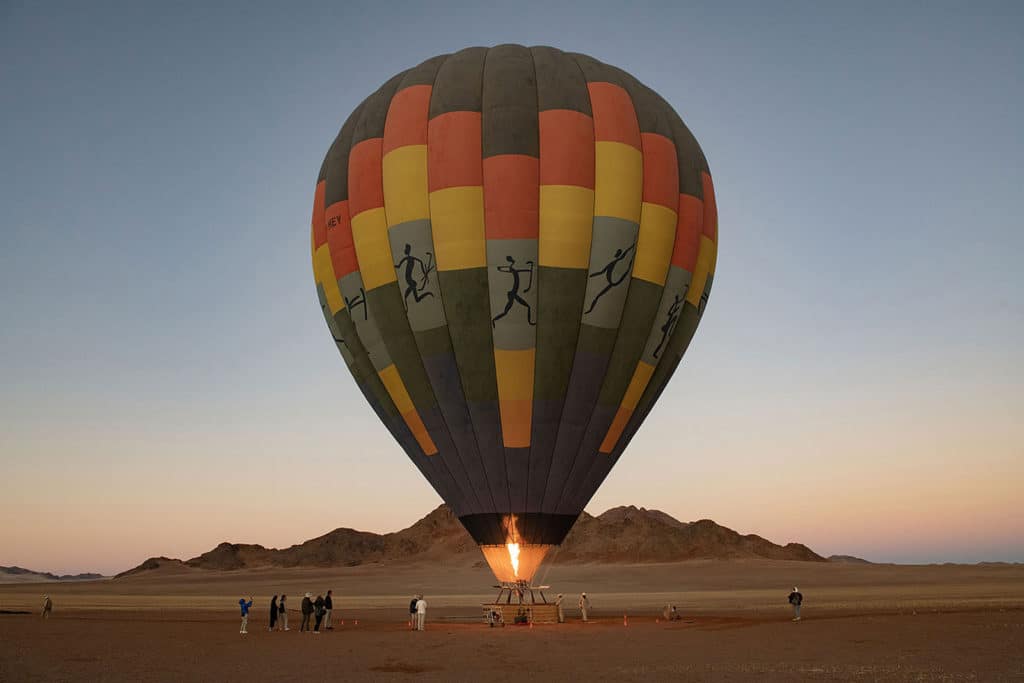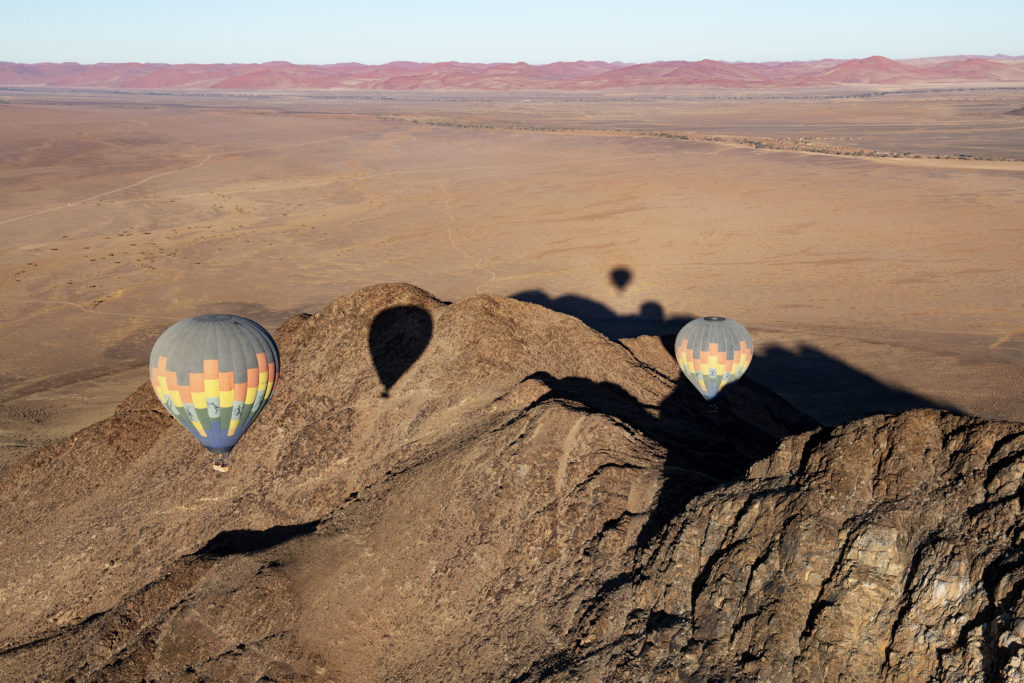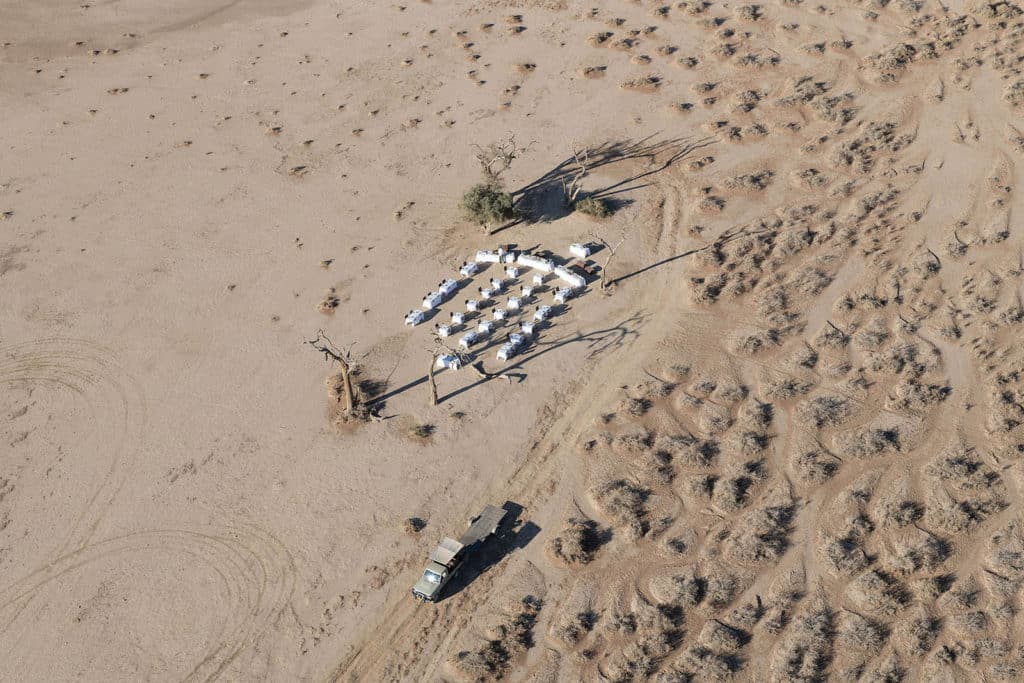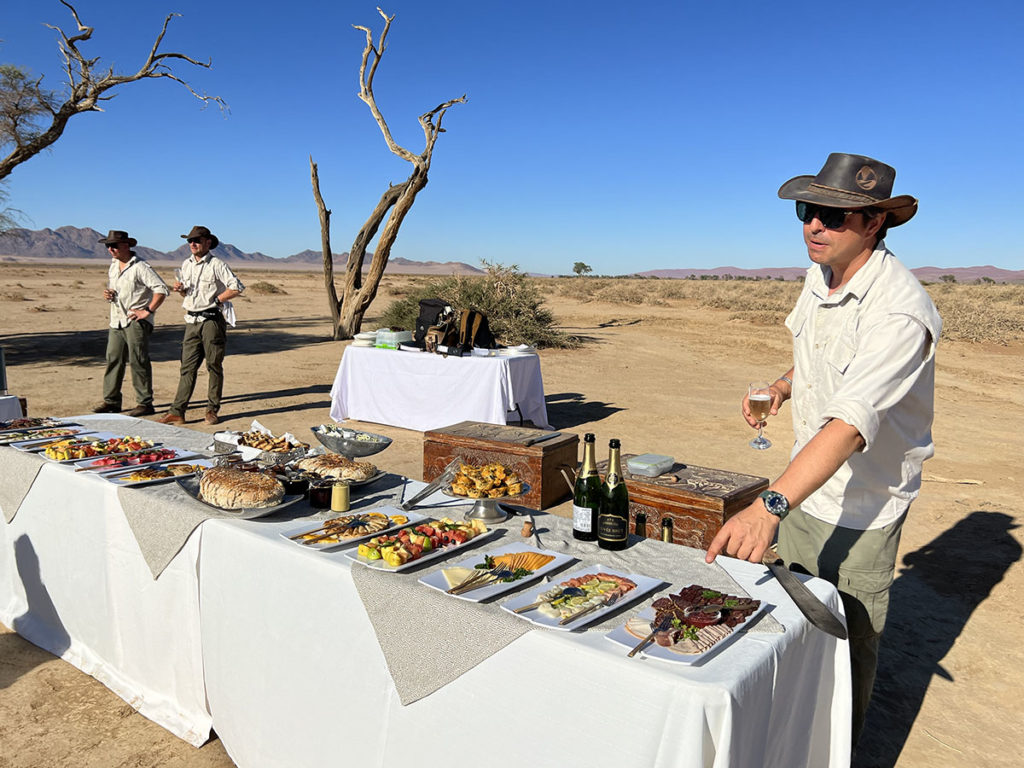The desolate Namibia offers the ideal environment for reflection and silence. We all yearn for that more and more. At the same time, the West African country is a perfect backdrop for grand adventures through its pristine wilderness.
Text: Angelique van Os | Photography: Henk Bothof
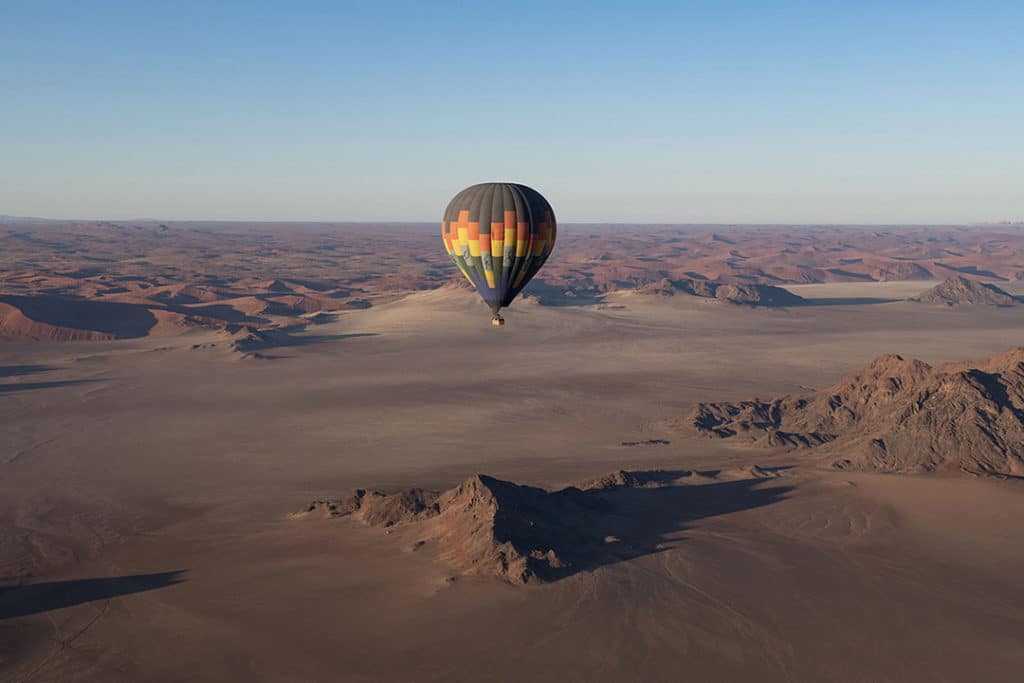
Namibia is waking up early in the morning. The sky turns orange-pink with yellow patches of the rising sun. The burner scratches strongly and spews out a good flame. The heat burns on our faces. Here we go, silently up. Within seconds we float at an altitude of 1100 meters above one of the most extensive and oldest deserts of our planet: the Namib. The flame goes out and the deafening silence returns. There is no comparable place on earth like Namibia. It is synonymous with desolate, rough and untouched. A land full of contrasts, where mammals have adapted to the appalling conditions of the desert. They are perfect ingredients for an unforgettable adventure.
Highest dune mountain range
The early morning light dances gracefully over the brown mountain tops, which take on a light blue sheen. It has an enchanting, almost serene effect. In the distance, the high, undulating dunes of Sossusvlei turn ocher red. Unfortunately, there is not enough wind to reach these eternal dunes, of which Big Daddy is the highest climbable mountain with its 325 meters. But luckily we have already plodded through the loose dune sand with a beautiful view over the famous Deadvlei; a surreal clay plain with ancient dead camel and maple trees (see box). There seems to be no end to the highest dune mountain range in the world. From the air it is even more visible how vast this immense primeval land is.
Namib Sky Balloon Safaris
Our pilot’s name is Dennis Hesemans. He is a cheerful guy with a sharp sense of humor and owner of the organization. Dennis was already in a balloon as a 4-year-old toddler and was taught sailing by his parents who founded Namib Sky Balloon Safaris in 1991. He now runs the company with his wife Andreia, which is an important source of income for the local communities and for future generations. Since 2011, children from miles around can go to the Namib Sky Community School – Little Bugs-, a sewing workshop has been set up and there is a fruit and vegetable greenhouse.
Driving skills
When Dennis adjusts something or wants to go down or up, he uses the burner. When we hit a mountain almost unnoticed and the other two balloons approach closer, there is some commotion in the basket with 15 passengers. But Dennis knows exactly what he’s doing. With extreme precision and a fine example of steering skill, he maneuvers the balloon along the top. It is remarkably quiet on the road. Everyone seems lost in their own thoughts or overwhelmed by the serene view.
Desert champagne breakfast
While descending, a group of white dots gets bigger and bigger. Are those covered tables?! “There’s your champagne breakfast,” says Dennis with a big smile. A delicious, extensive breakfast buffet awaits in the middle of no man’s land, a fantastic end to an unforgettable morning.
Background Namibia
West African Namibia, with its 2.5 million inhabitants, is one of the least populated countries in the world, with an area the size of France and England combined. Namibia, which lies on Africa’s southwest coast, was oppressed for centuries by German, British and South African rule. Namibia only separated from its neighbor in 1990.
The Namib desert is over 80 million years old and with 50,000 km2 the largest national park in Africa. The park actually consists of three areas: the Namib-Naukluft , the Namib Desert Park and the adjacent Sperrgebiet. The latter was the diamond concession of De Beers, forbidden territory since 1908. Now it has been renamed an exclusive national park that is open to a very limited public.
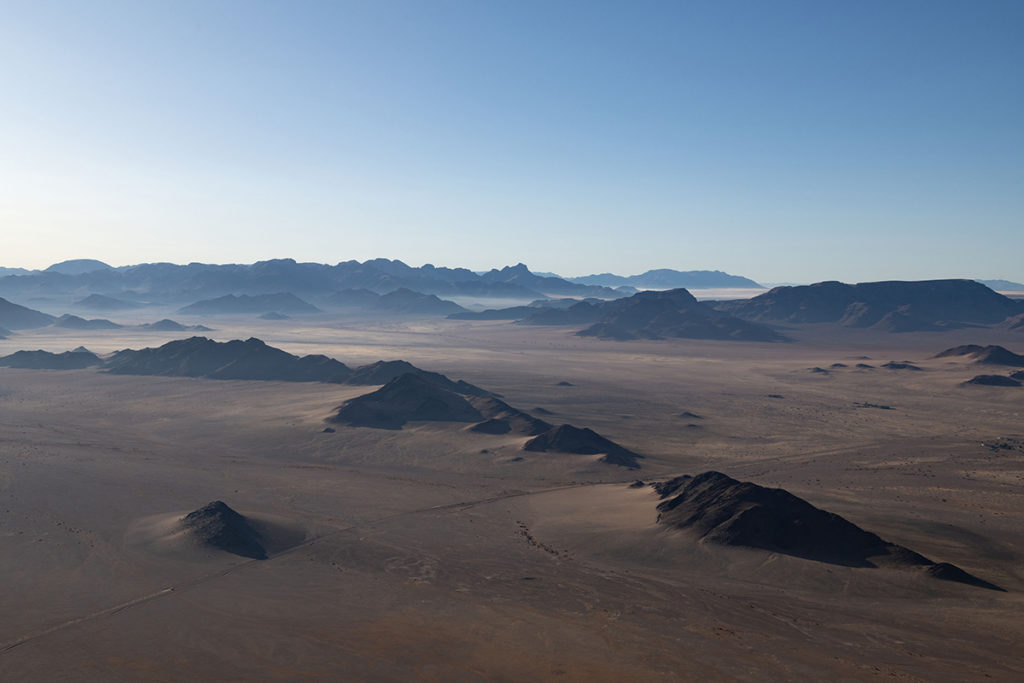
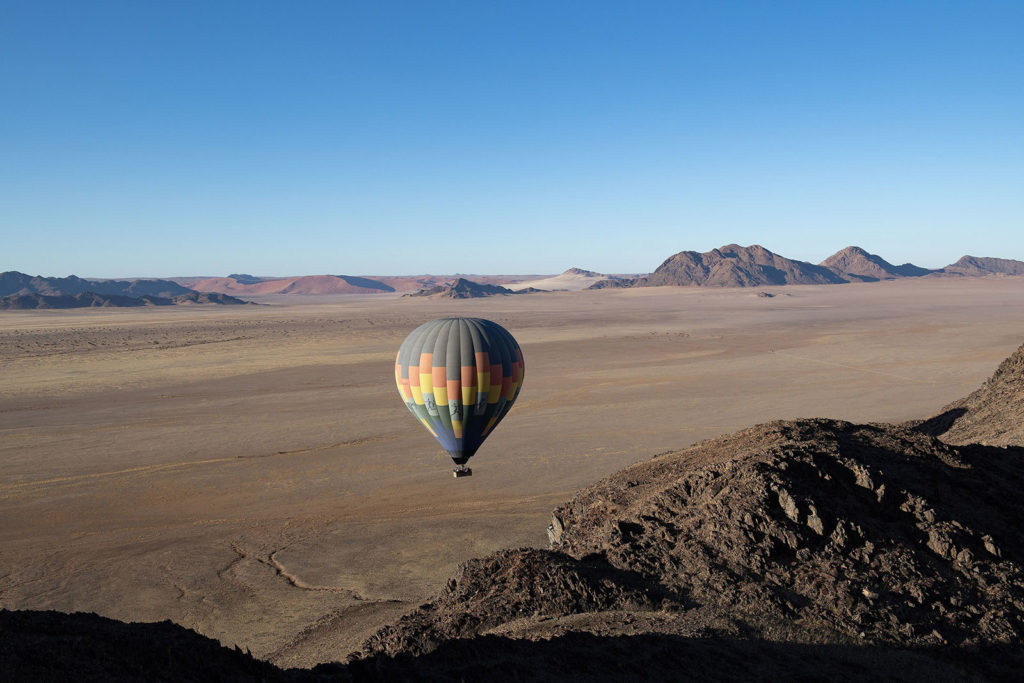
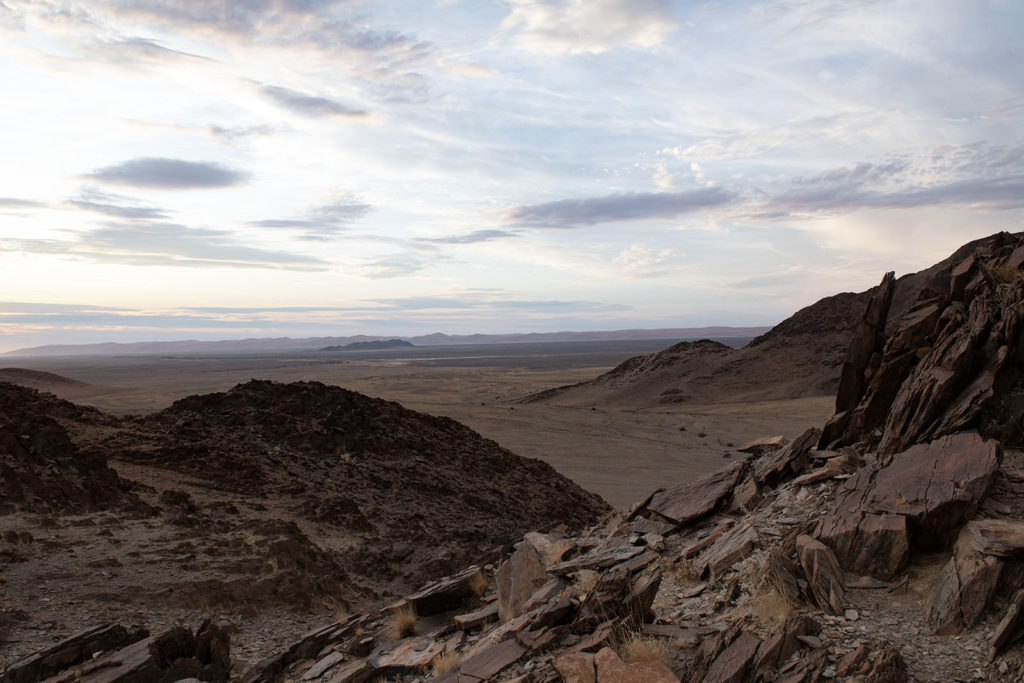
Sossusvlei
One of the highlights of Namibia is without a doubt Sossusvlei. Sossus is derived from the African Nama language and means place where waters comes together. Vlei stands for: lake. Both refer to the sporadic rains that converge in the Tschauchab River and the water that remains in the dry vlei. As a result, the clayey soil flourishes with various crops. The sand of the dunes consists largely of silicon. The red glow comes from a thin layer of iron oxide. The sand is supplied from the Kalahari via the east wind. Thanks to the cold air current of the Atlantic Ocean, plant growth is possible.
The nearby Sesriem Gorge is also well worth a visit. Tip: go at the end of the day, at dusk when it is a lot quieter and you may have the gorge to yourself.
Deadvlei
Deadvlei is the salt pan that formed a branch of Sossusvlei about a thousand years ago. This place, with its cracked clay soil (liam sand), is reminiscent of a surrealist painting by Salvador Dali. Climbing one of the adjacent dunes takes some effort, but the view over the ‘dead lake’ is spectacular.
Although Sossusvlei is busy, those who come early have the chance to take in the surroundings and Deadvlei in peace. Wilderness guests also have an advantage, because the organization has a private entrance gate that makes it possible to be present in the park earlier than others.
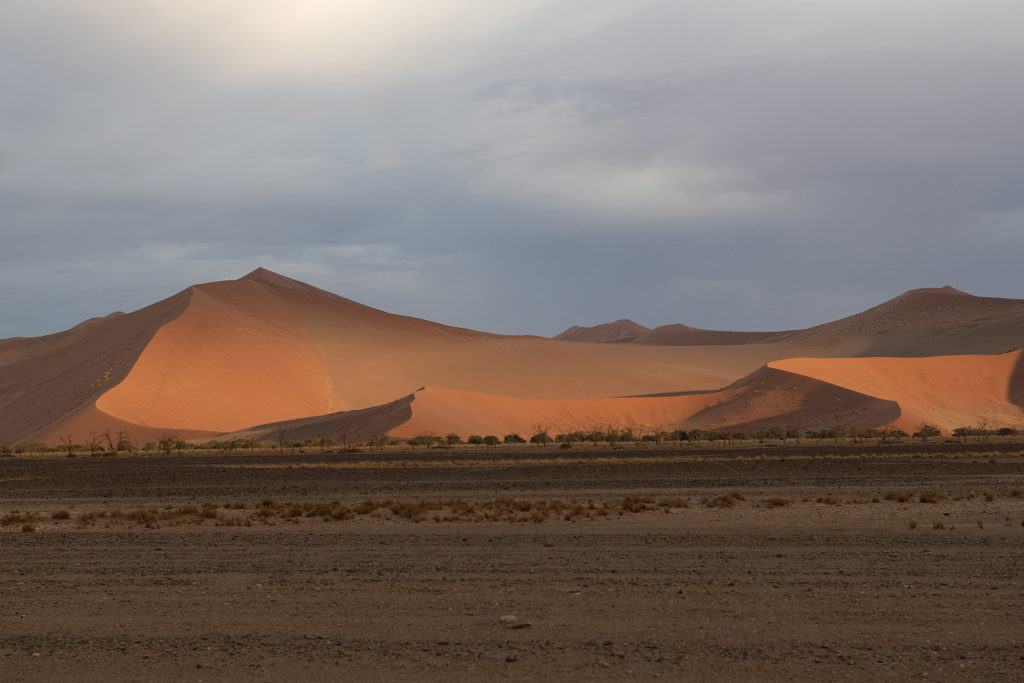
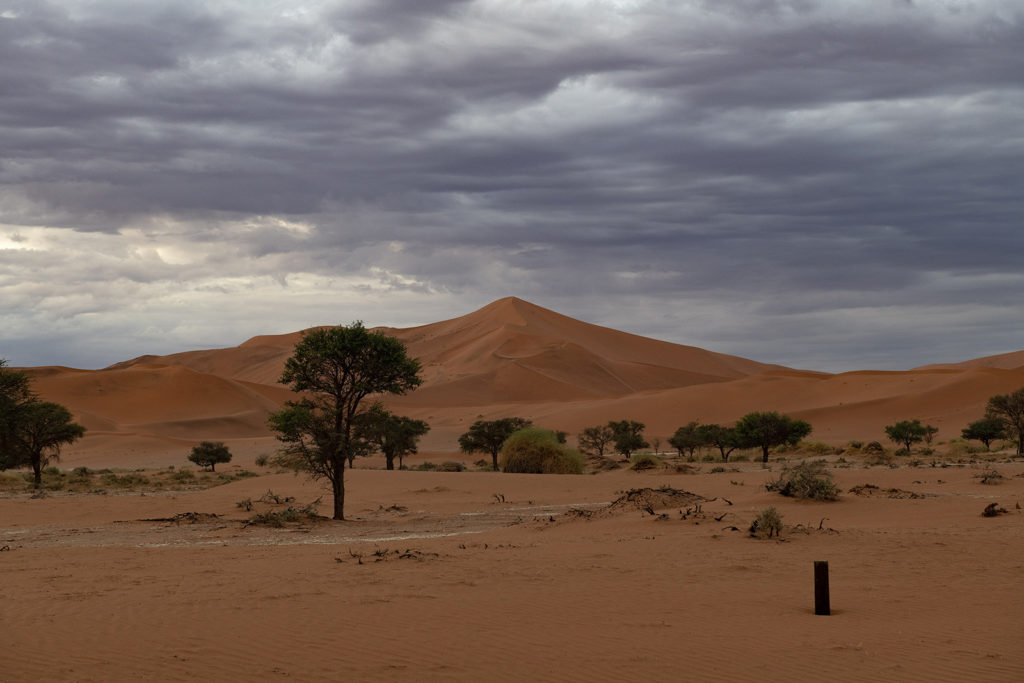
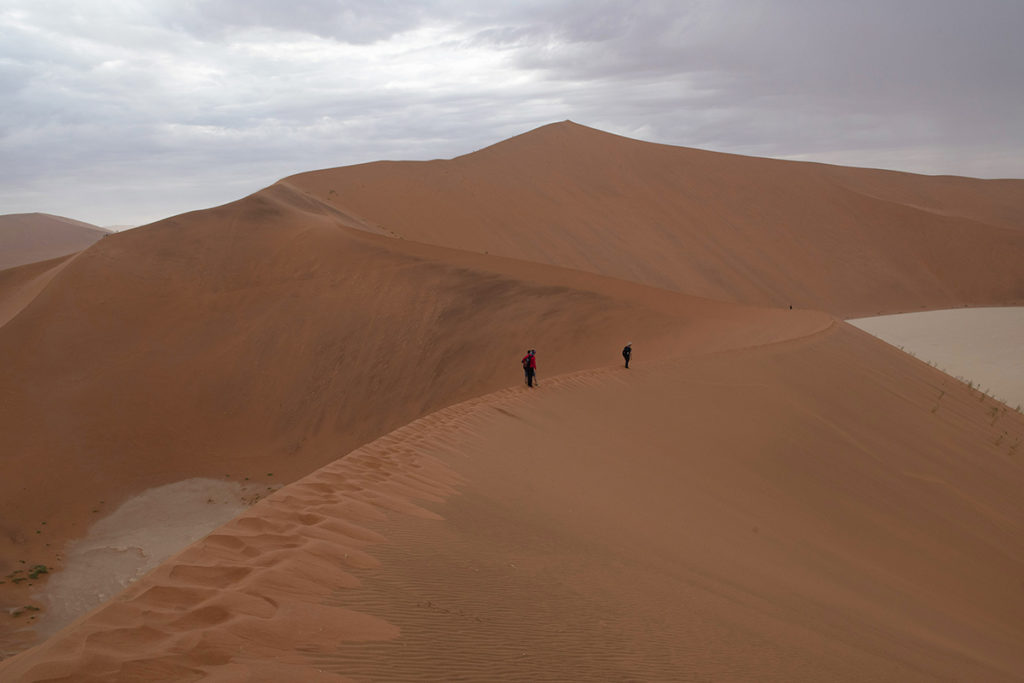
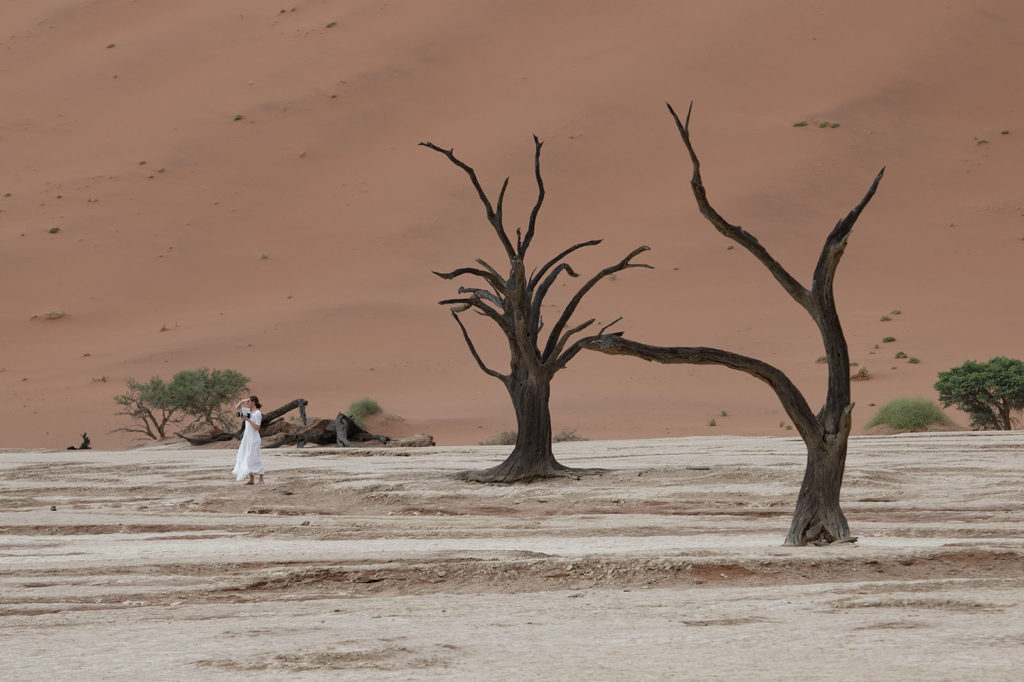
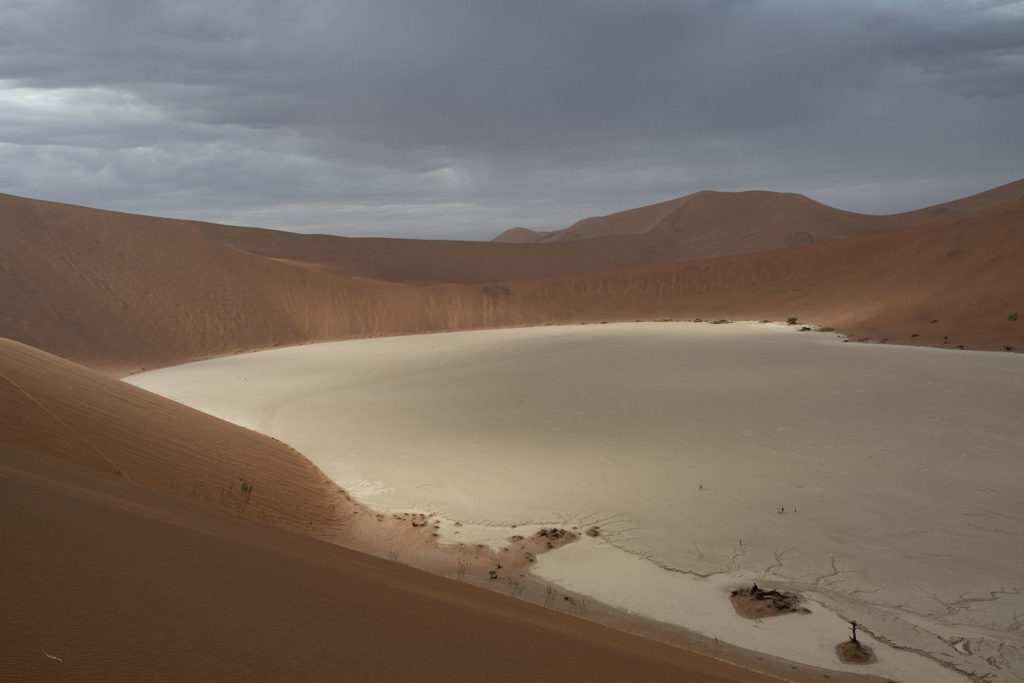
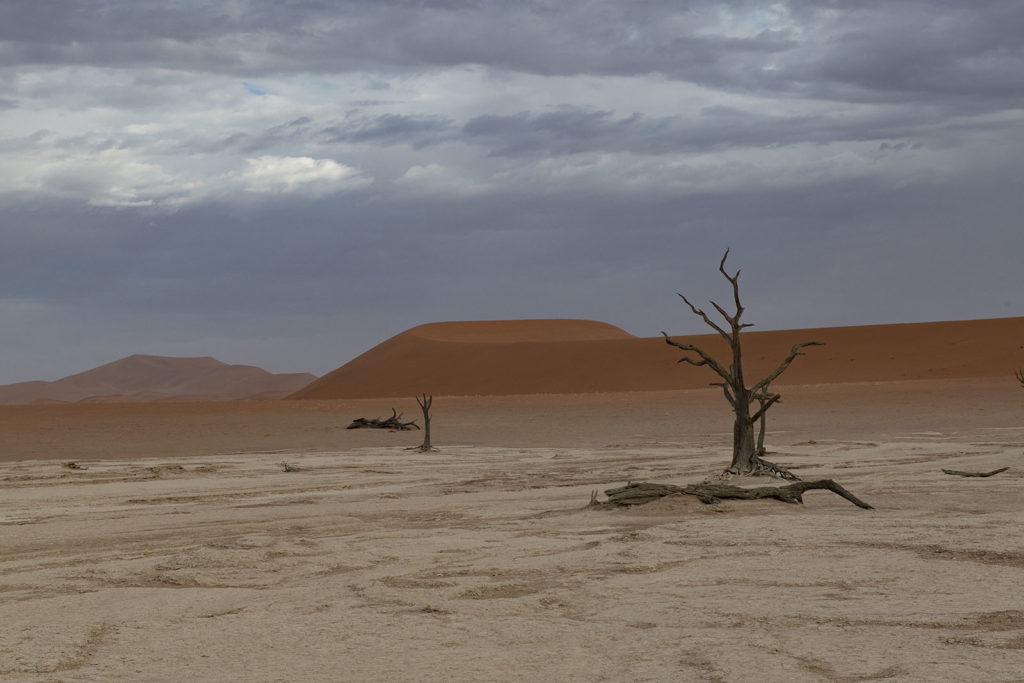
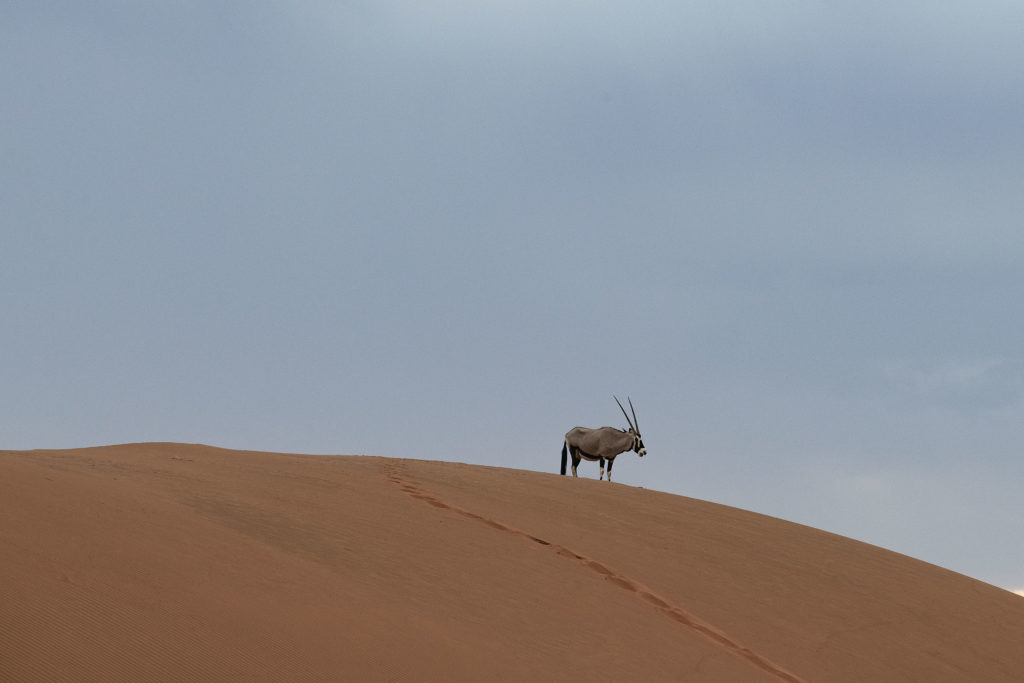
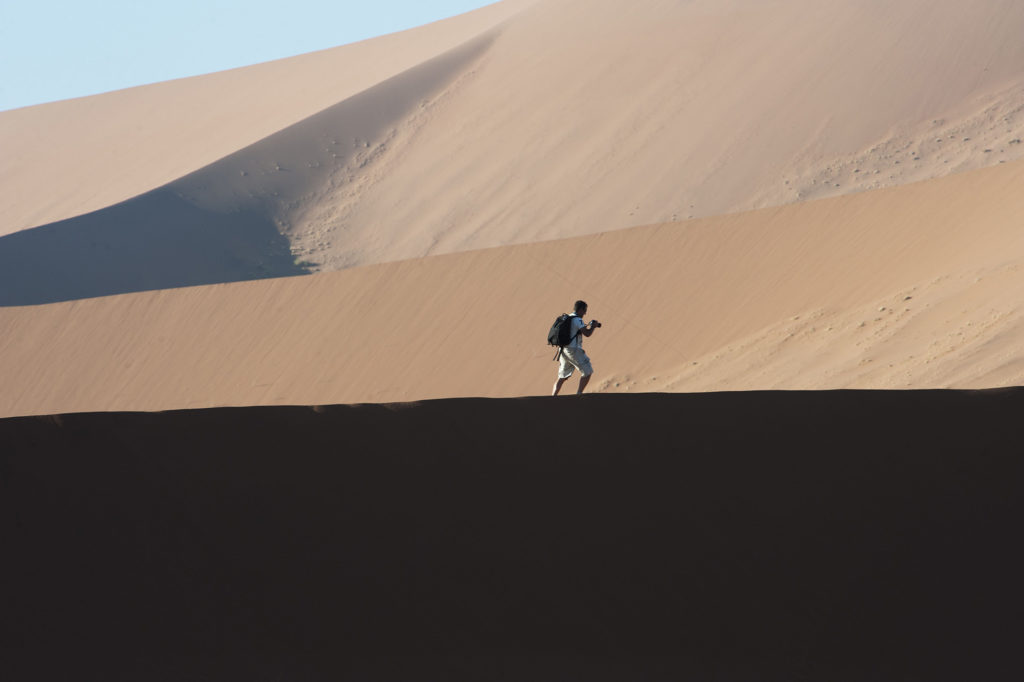
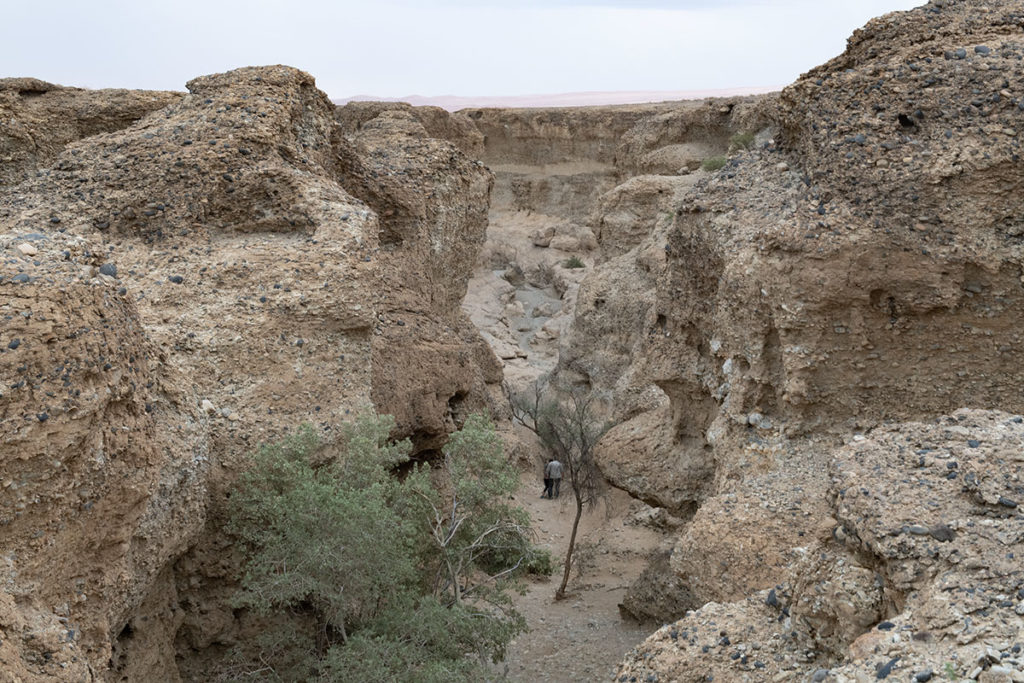
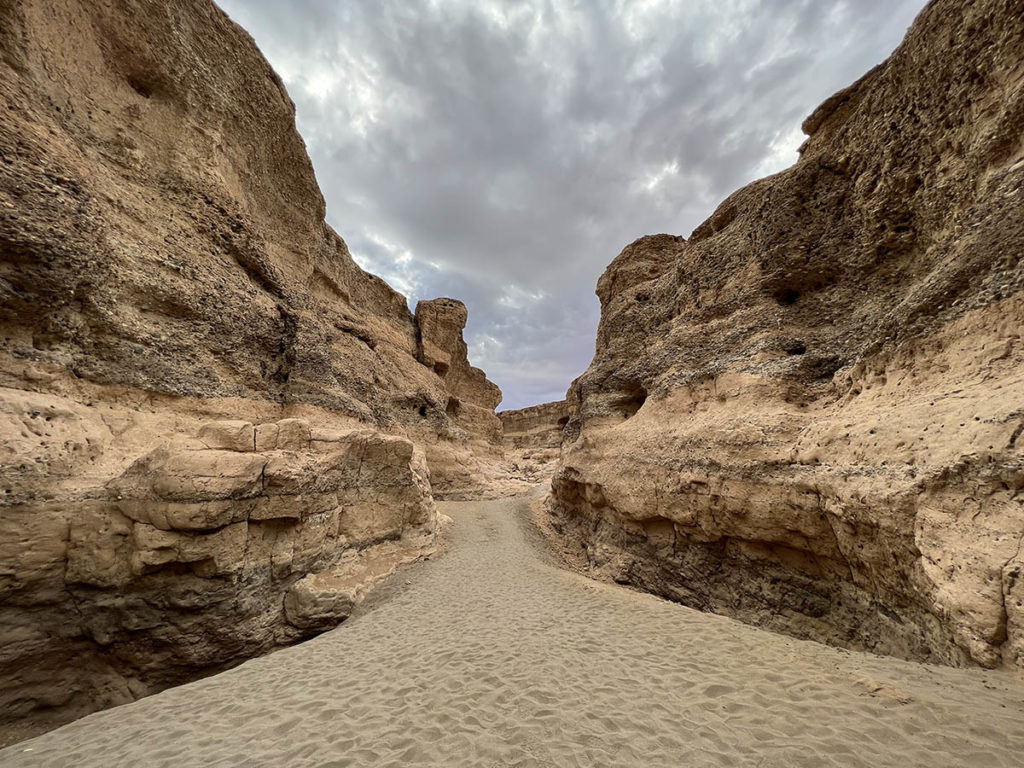
Namibia from the air
It doesn’t stop with this one flight, because those who want to experience the many faces of Namibia optimally and cover long distances in a short time, do this best from the air. That is of course less sustainable than traveling by car, but the emissions of the small Cessna aircraft with which we travel are low in their CO2 emissions and are compensated by the Africa specialist Wilderness with which we travel, by planting new trees.
Transformations landscape
The splendor of the landscape shows itself in all kinds of shapes and colors. Between Sossusvlei and the inland Damaraland alone, we see transformations from endless red dunes to vast coastal strips where exuberant patterns of drained rivers find their way from the sea to the interior.
Drought is a major problem in Namibia, although short periods of heavy rainfall are more frequent due to climate change. Yet the rivers are dry for most of the year. Animals often only get water through rising fog that drifts into the land with the help of wind currents from the sea. The sea is therefore an important lifeline; the desert flows into the billowing sea, like a union between body and soul. Together with the rivers, it forms an important corridor for animals that migrate between the desert and the Atlantic coast, as is the case in particular with the Skeleton Coast. ->>
Damaraland
The closer we get to Damaraland, the rockier and rougher the landscape becomes. The dunes and plains have made way for imposing inactive volcanic craters, table mountains and rolling savannas. The undulating, winding mountains look like an oil painting from the air, with circles and colors flowing into each other. Ten years ago we also visited this lesser known area which is about 200 kilometers above Swakopmund. Wilderness manages a concession of 1500 km2 that is part of the Palmwag area within Damaraland. The total size of this is 5800 km2, about 450,000 hectares. Hardly anything has changed, untouched nature reigns and few people live in the immense area.
Save The Rhino Trust
In addition to the natural beauty, those who visit Damaraland mainly come to see the black rhinoceros in action. It’s still possible here. The black rhinoceros is one of the most endangered species in the world. There are only about 5,000 wild specimens living in West and Central Africa. In the 1970s, there were only between 20 and 50 black rhinoceroses in all of Damaraland. They were killed for their precious horns. Fortunately, since Wilderness joined forces with the Save The Rhino Trust (SRT) and the Department of Environment and Tourism in the early 1980s, much has changed for the rhino.
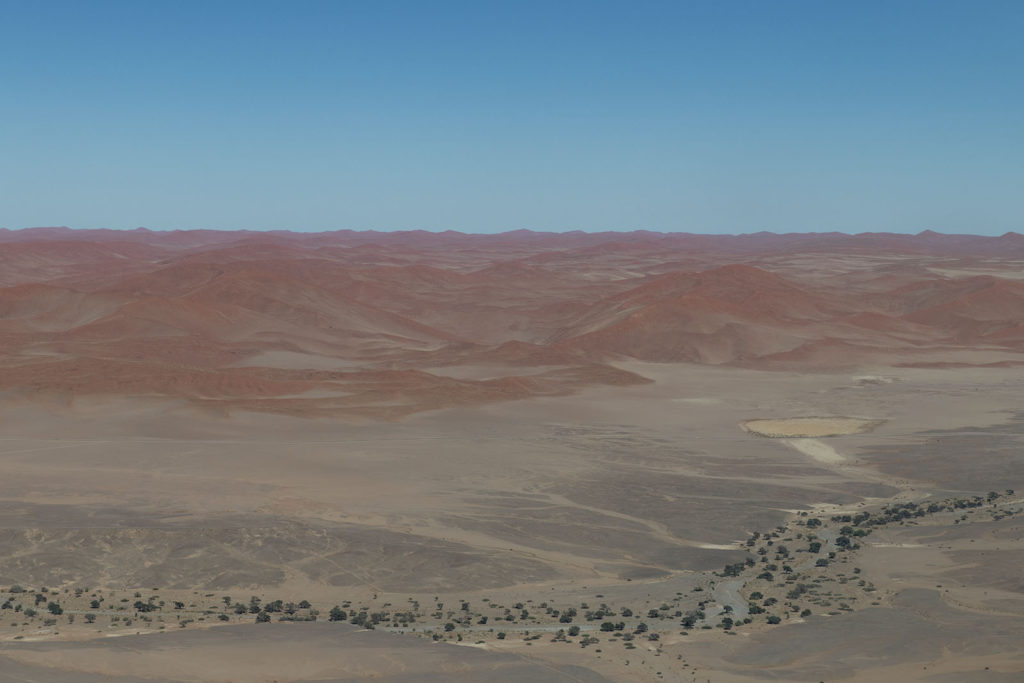
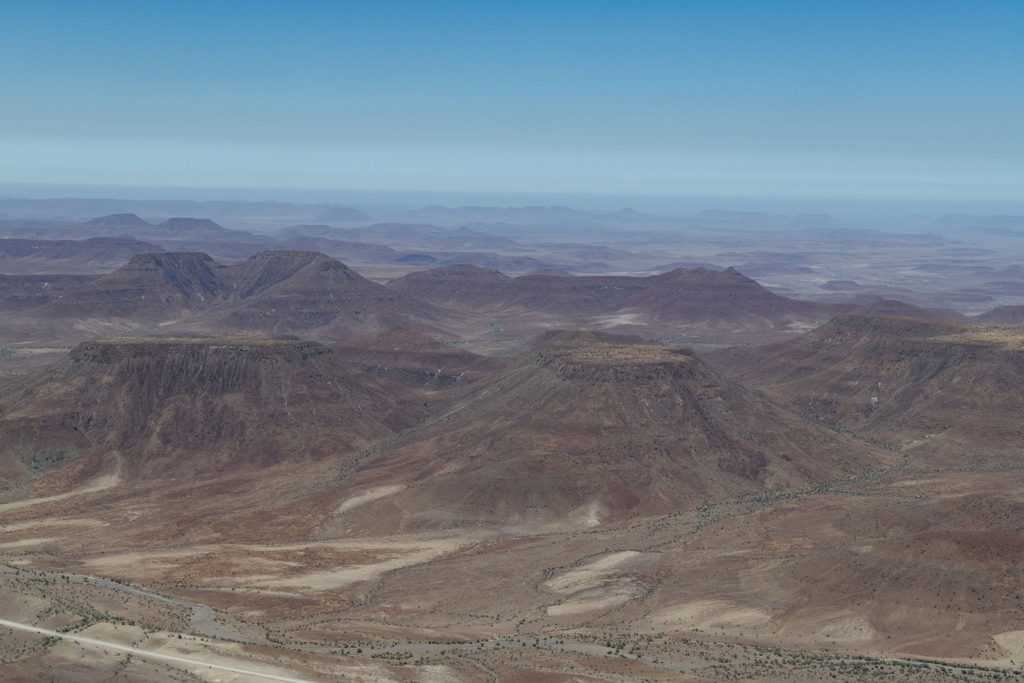
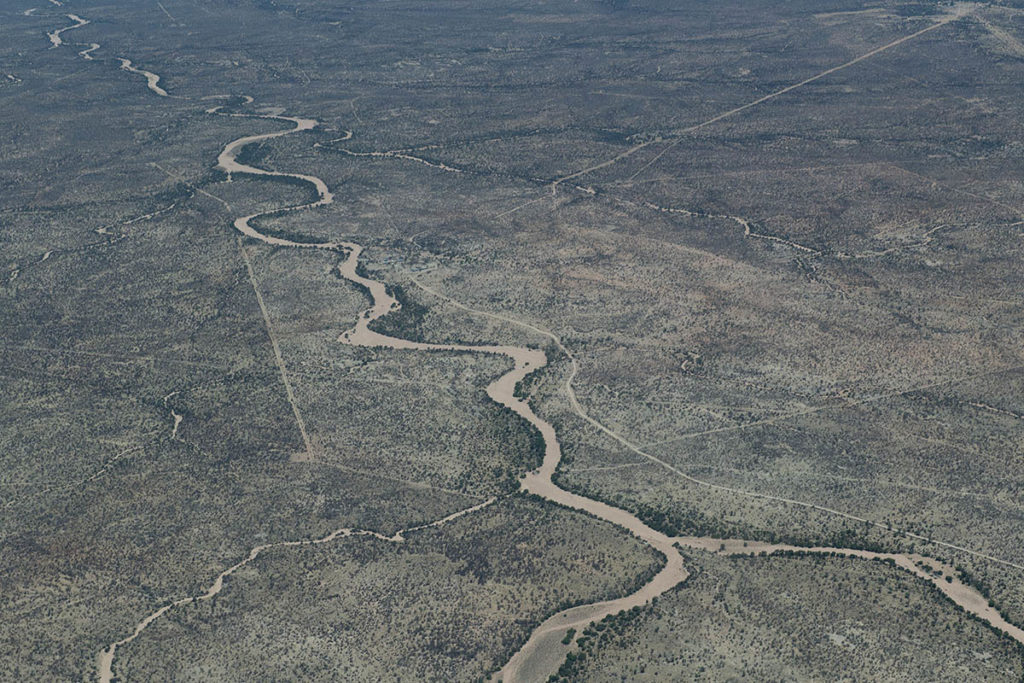
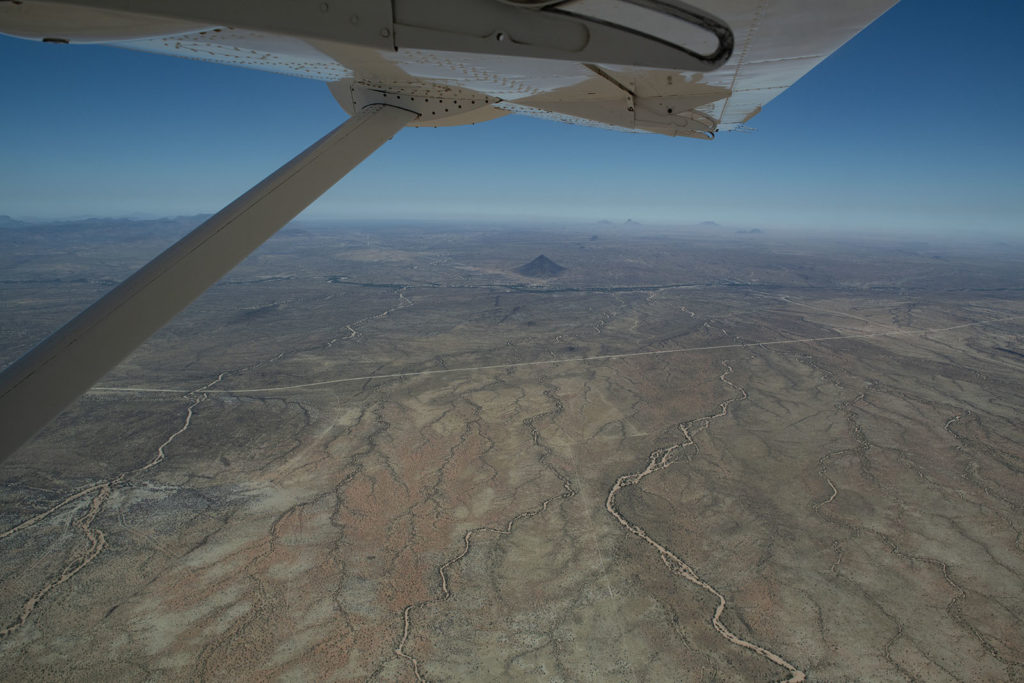
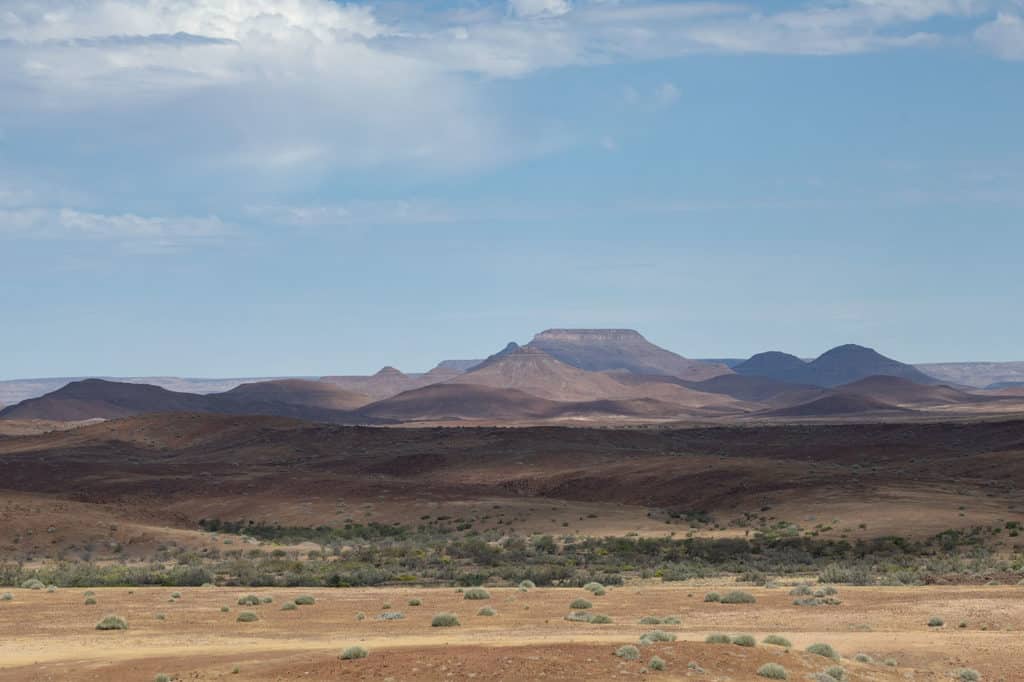
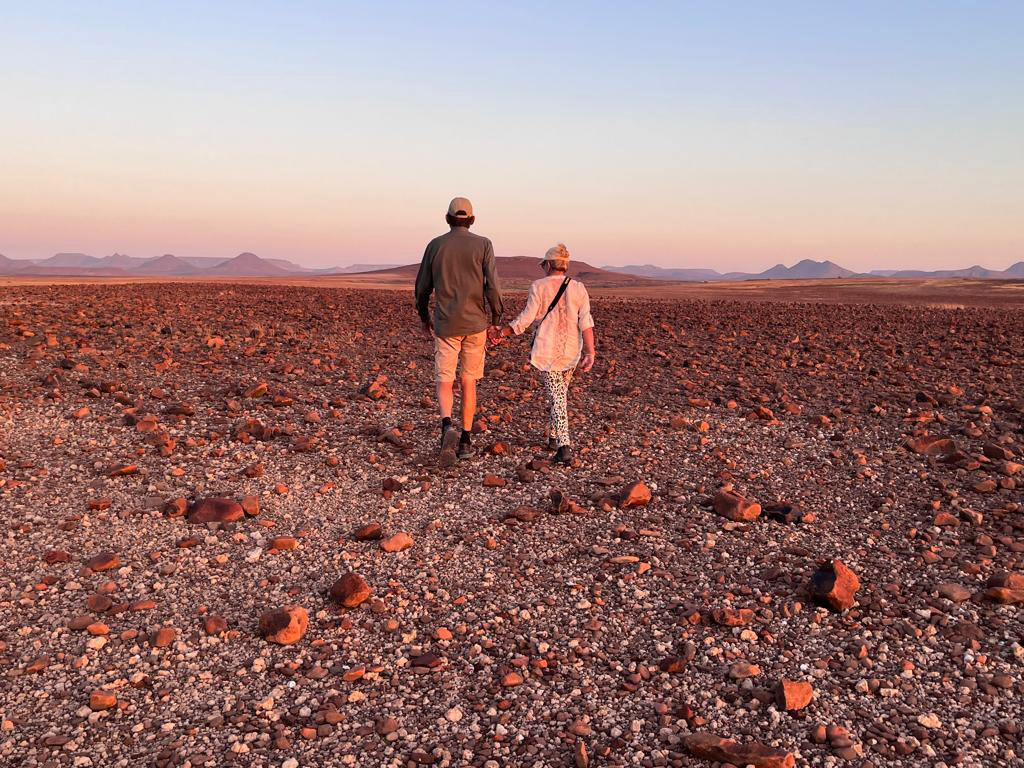
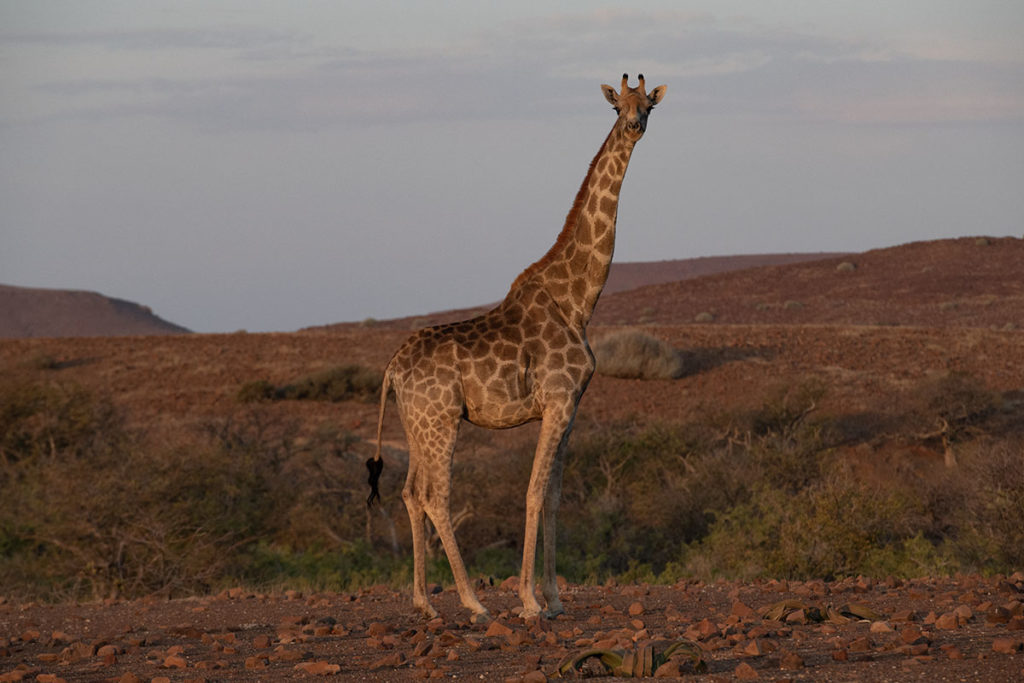
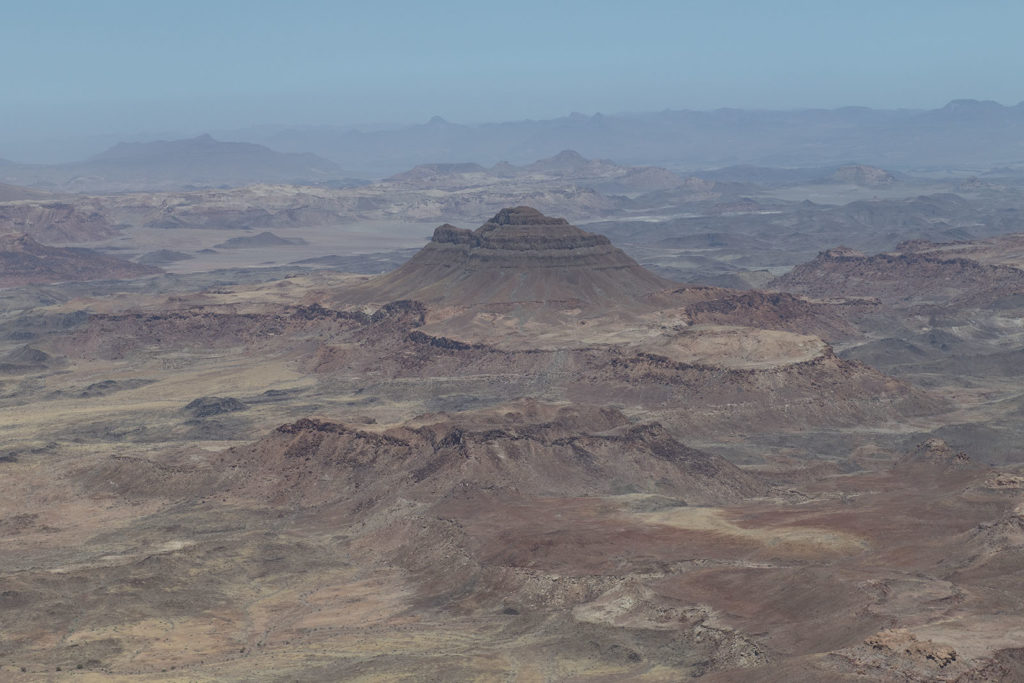
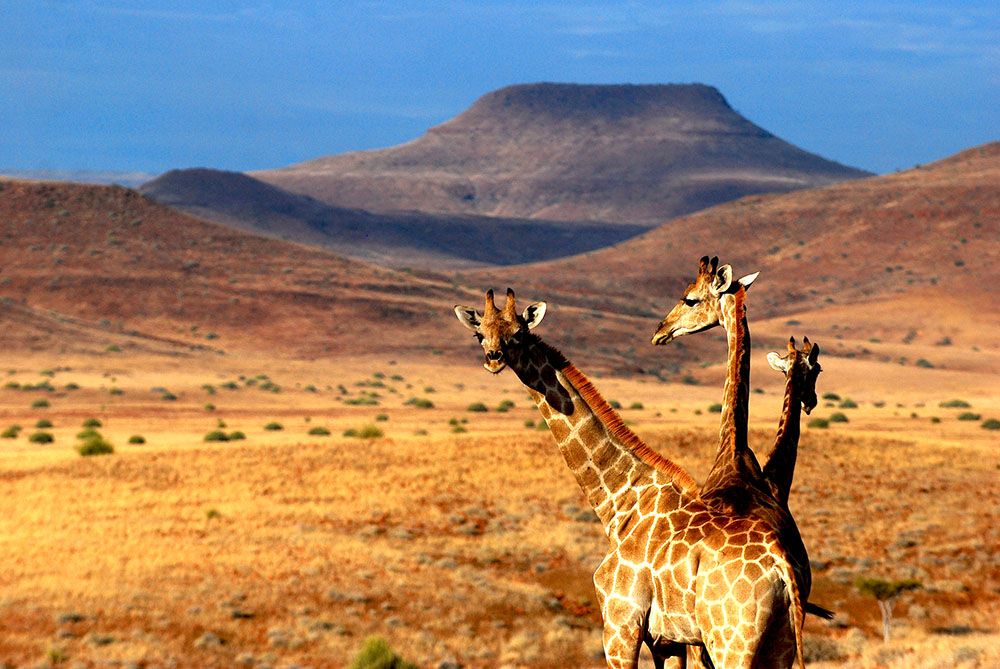
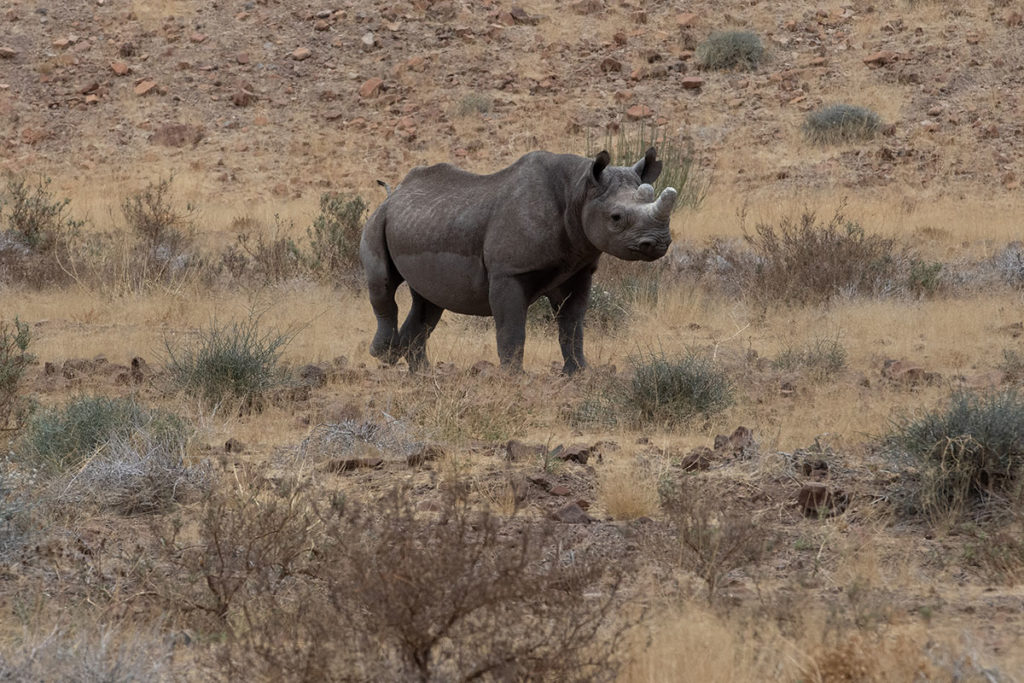
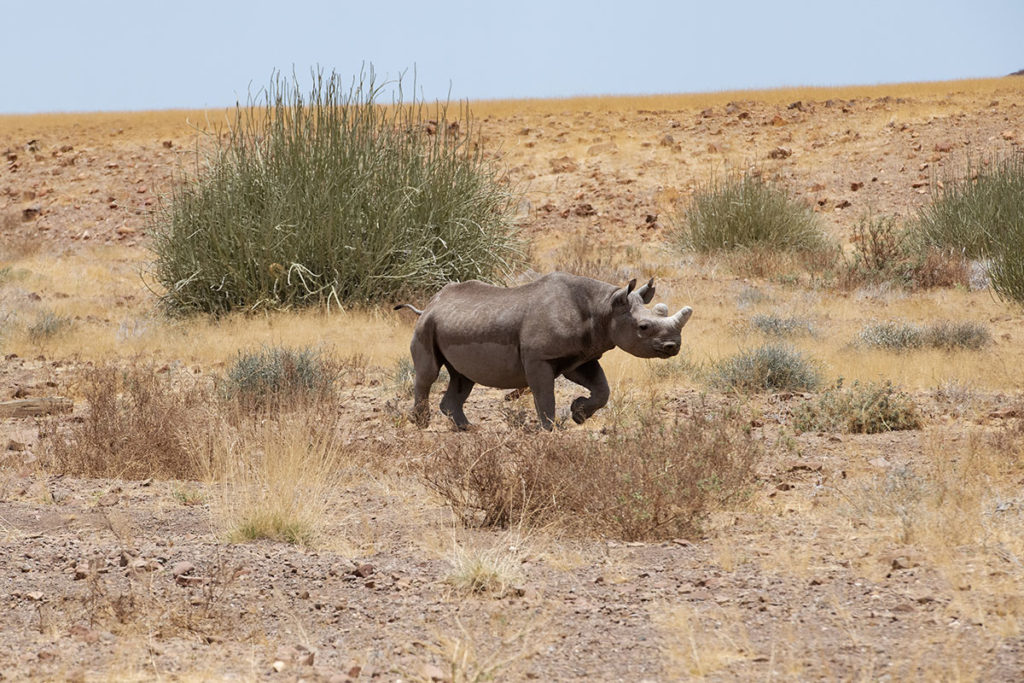
Zero poaching
The population has more than doubled in recent years and thanks to tight monitoring and protection by Wilderness rangers, among others, there is even zero poaching within the Palmwag concession, in other words: not a single rhino has been killed by poachers. The animals that perished died of natural causes; like Ben, a dominant male we spotted on our last trip.
Pride
“We are very proud that more than 20 rhinoceroses live free in our concession alone without being hunted,” says our guide and rhinoceros expert Bernardo Hillary ‘Bons’ Roman (Bons for short). More and more locals are recognizing the importance of nature conservation and sustainable tourism. Compared to ten years ago, more people are now involved in SRT and Wilderness. More than 200 households from miles around can support themselves through this work and pass on their knowledge to the next generations,” says Bons.
The downside is that life is becoming increasingly difficult due to extreme drought and food scarcity. Climate change is also visible here. And despite the fact that few people live in the area outside the park, the numbers are increasing. Bons: “When rhinos smell trouble and their habitat is disturbed, they may migrate to our concession, because here the animals live in peace.”
Debutante
The next day we experience what Bons is talking about. After hours of driving on bumpy, winding dusty tracks we are lucky enough to observe two rhinoceroses from a suitable distance. The first rhinoceros is an independent male of four years old – possibly one of Ben’s last descendants – who keeps a close eye on us.
Two hours later, Bons spots a sleeping female under a tree and undergrowth with his hawk eye. This lady is not recognized by the rangers and trackers; she is a debutante in the area. It could be that she migrates and settles in the park. If she stays for more than two months, she officially belongs to one of the rhinoceroses of this concession. It’s a valuable day for the SRT team, because Wilderness’ sustainable tourism makes it possible to continue monitoring, registering and protecting the animals. Incidentally, the rhino tracking is a maximum of four times a week, to disturb the pachyderms as little as possible.
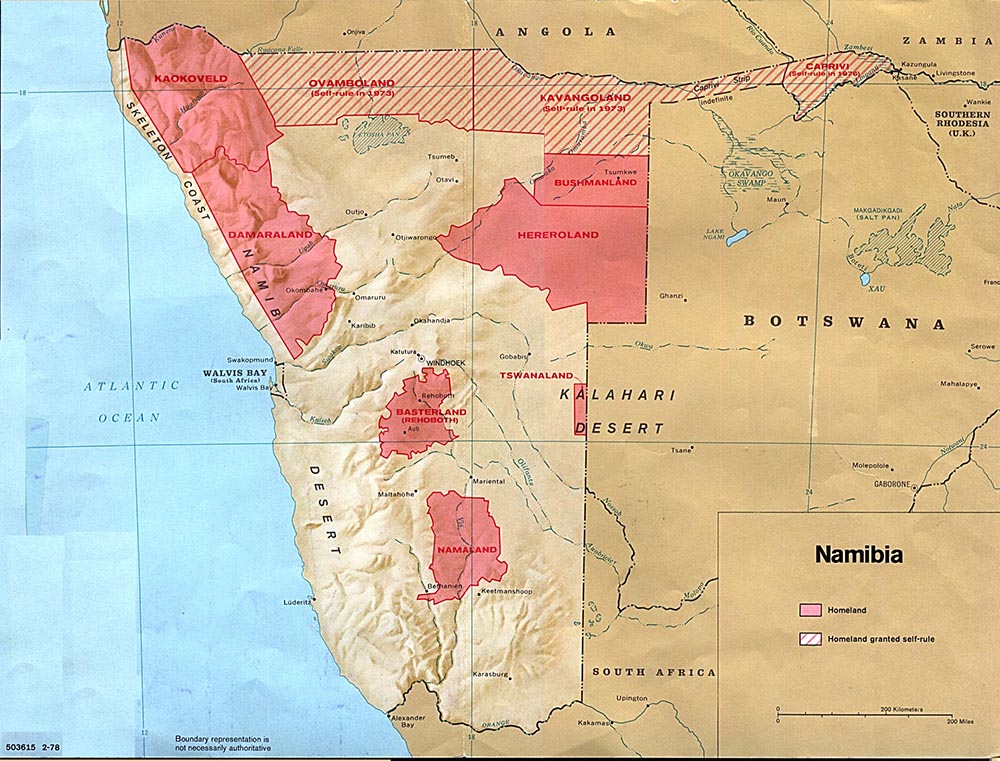
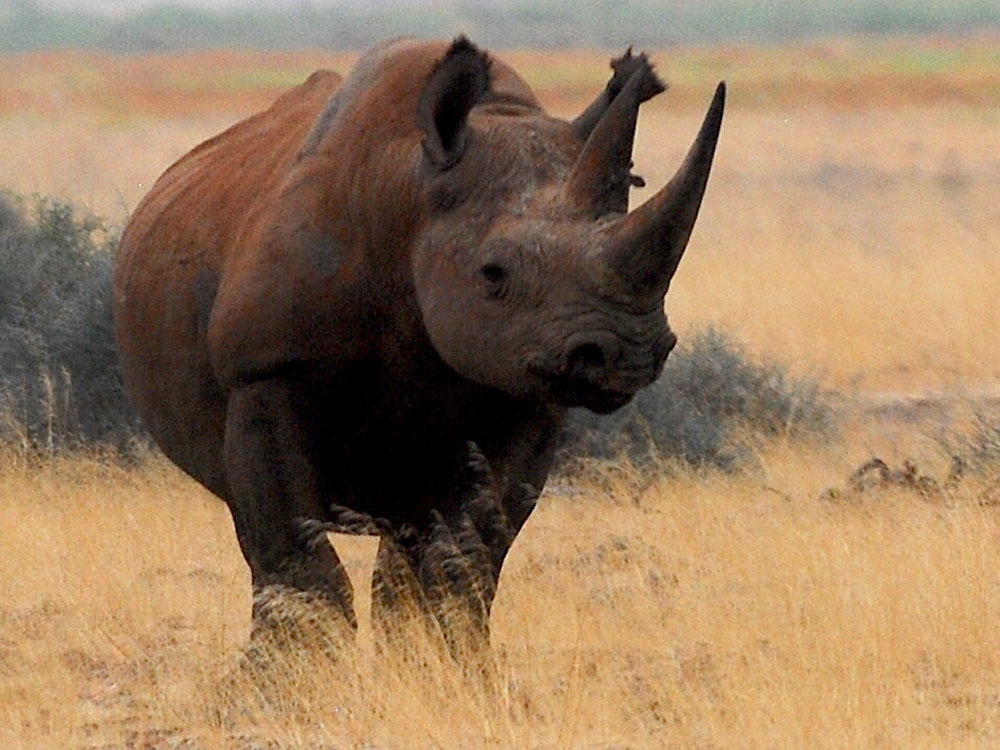
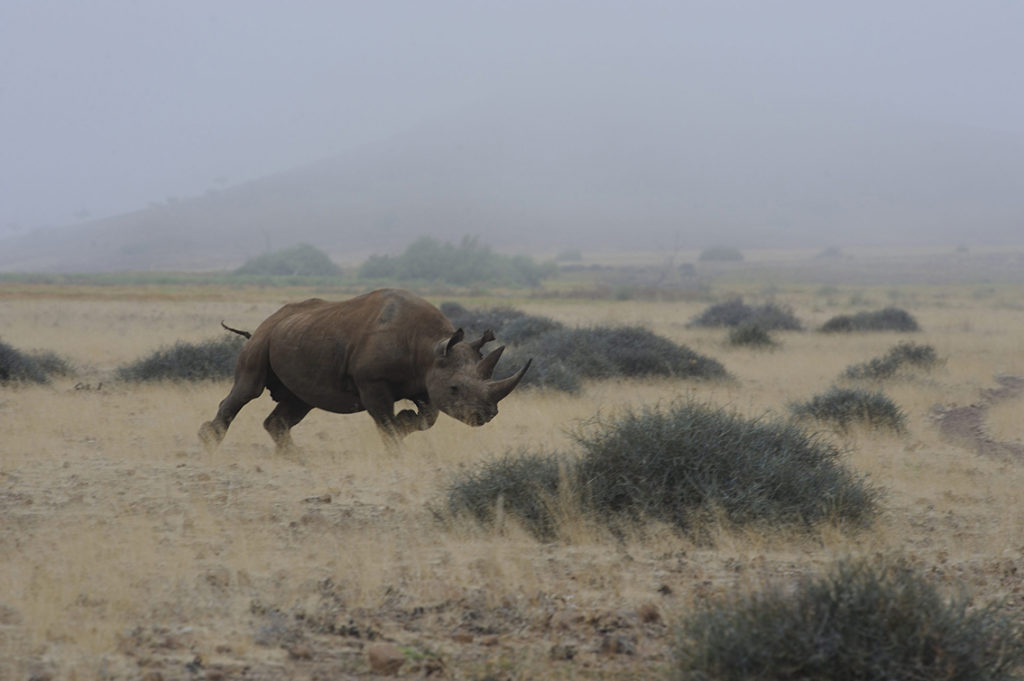

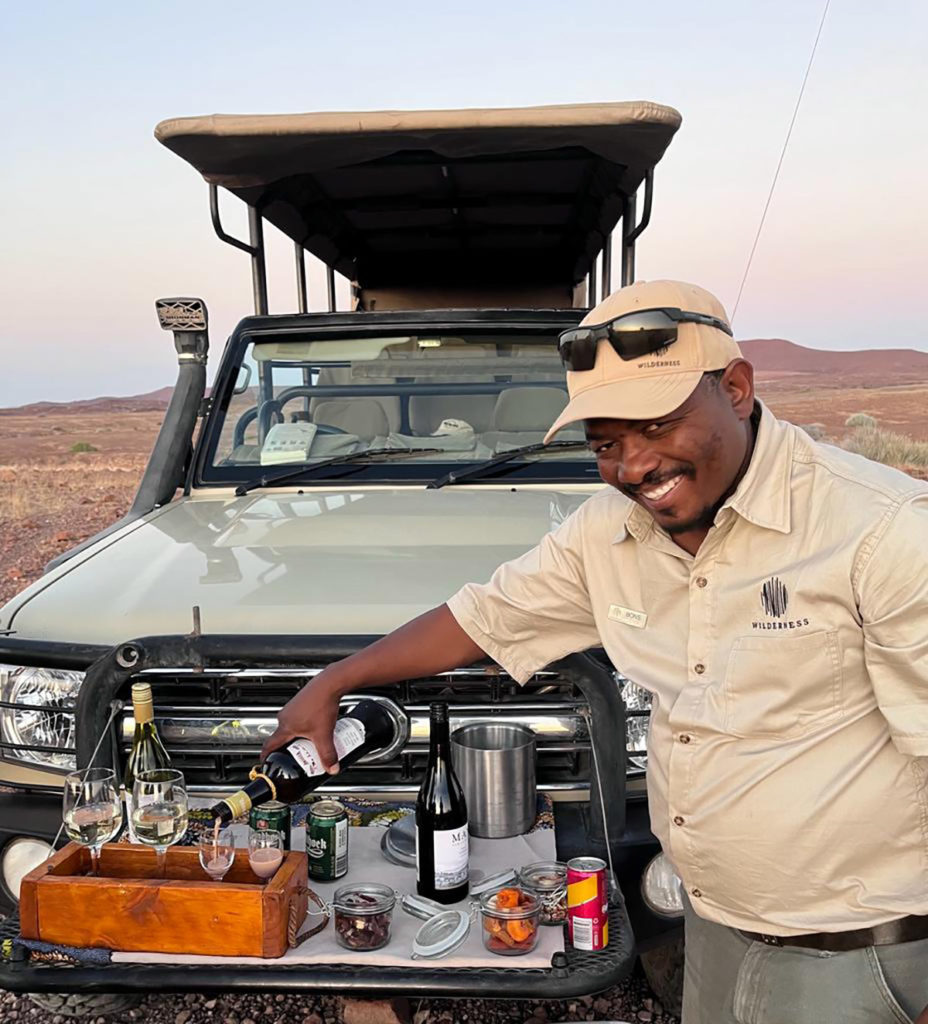
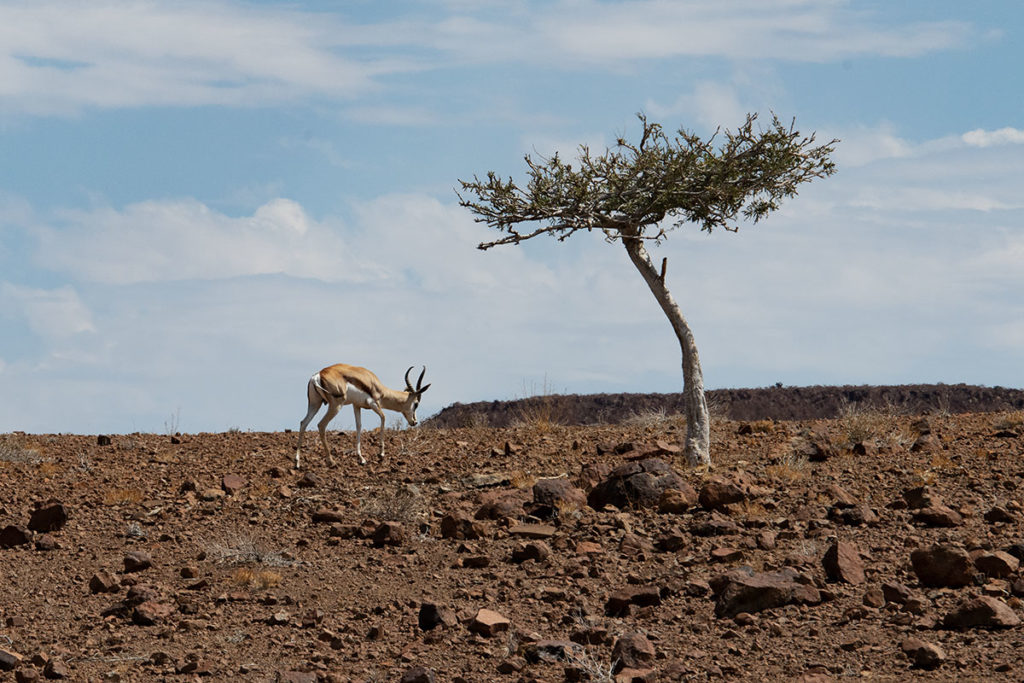
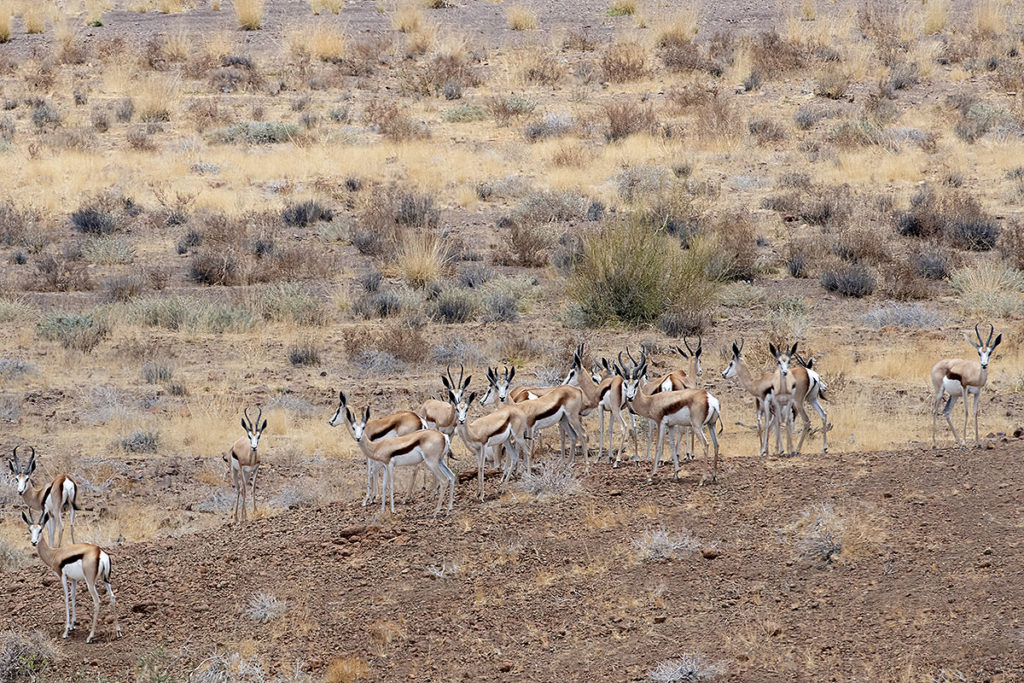
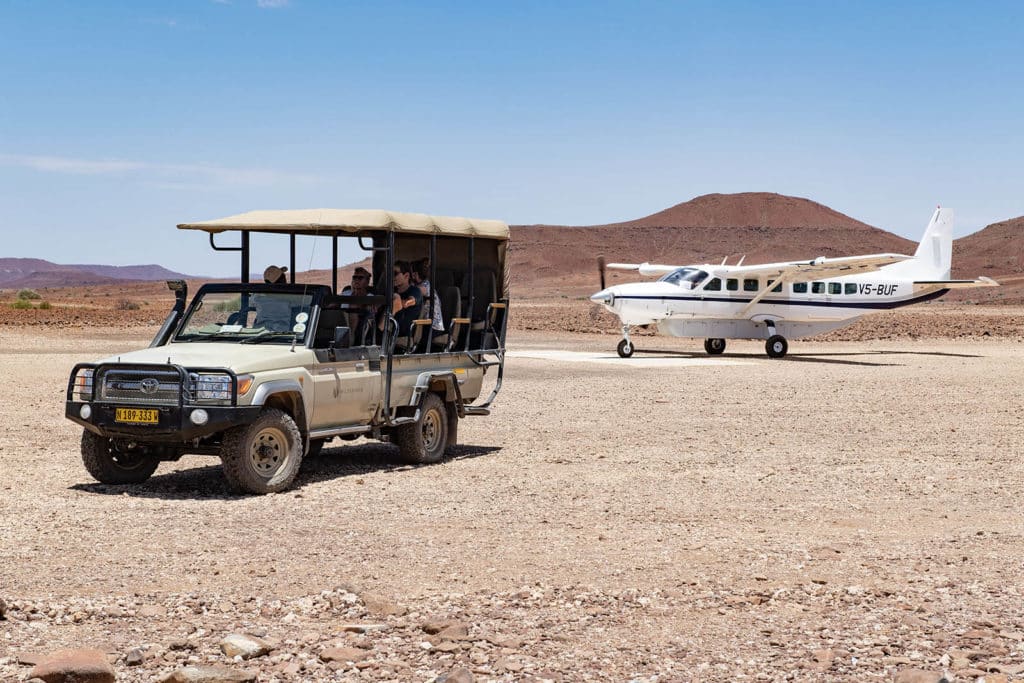
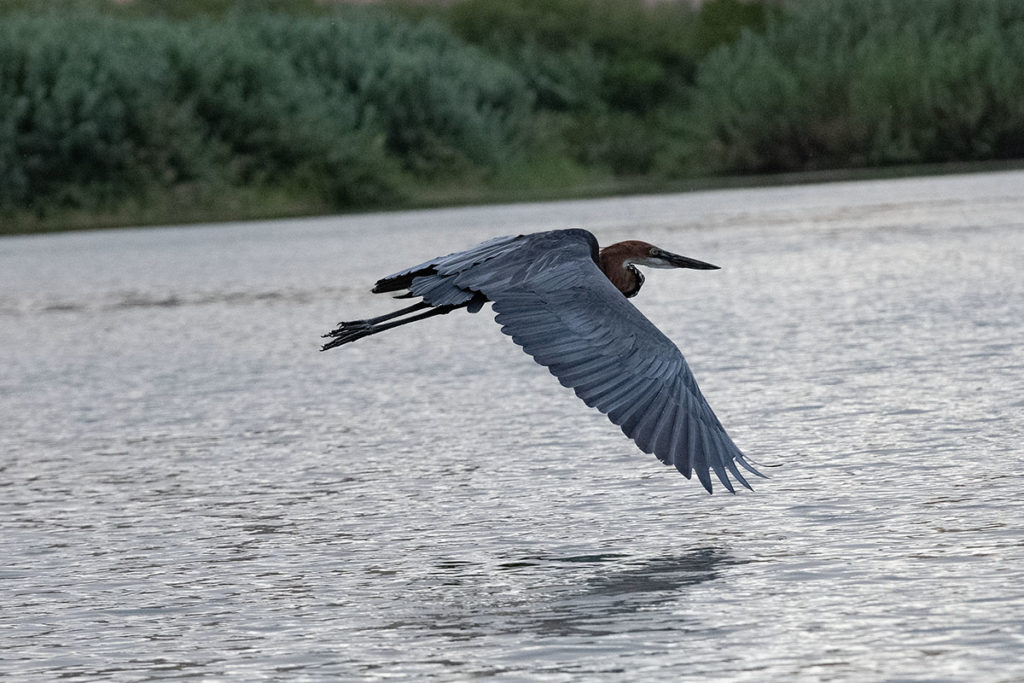
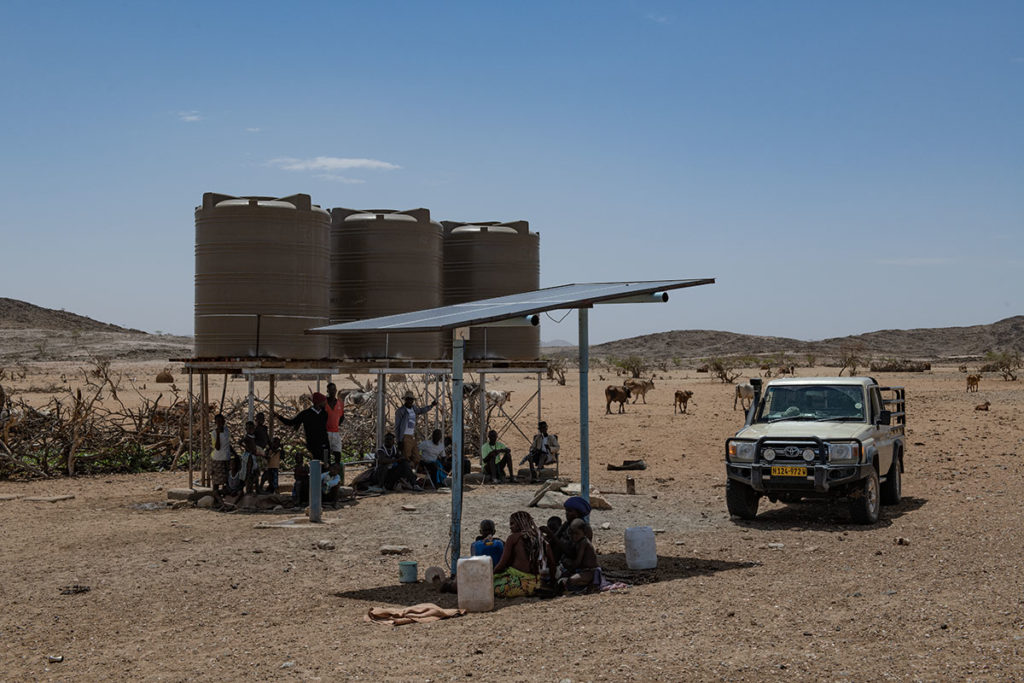
Marienfluss & Hartmann’s Valley
After two days we fly on to the Marienfluss concession, located in the northernmost and most remote point of Namibia. The almost saffron-red hills of Palmwag flow seamlessly into the vast sand plains and rugged mountains. The view never gets boring and when I immerse myself in all imaginable shades of brown and beige, I easily get into a meditative mood.
Arriving on the ground of Kunene region, this pristine force of nature continues tirelessly. From the airstrip we drive an hour through no man’s land. The Marienfluss and Hartmann’s Valley together cover 350 hectares. Wilderness is the only tour operator in this area to have its own lodge. Our new guide, Anthan, speeds up to drive the 4-wheel drive car over the rolling dunes. After a beautiful viewpoint we descend steeply. And then, when we least expect it, the Kunene River looms out of nowhere. Like a mirage, we suddenly see a green, lively oasis between all that sand, including Makalani palm trees and meter-high grasses. It is an unreal spectacle.
Kunene river
The Kunene is the only permanent river for miles around, winding 1,050 kilometers downstream from its source in central Angola. The other side of the water opens 45 kilometers further into the Atlantic Ocean. Thanks to the river, there is quite a bit of activity around the water; many bird species, fish and crocodiles live here. During a relaxed boat trip, Anthan says that the river can be 12 to 30 meters deep and can overflow its banks considerably during parts of the year. Due to the large rocks in the water, it is only possible to sail here with a small boat.
Crops
The only local population that regularly settles on the Kunene are the Angolan Kubare people. We visit a group of people who grow various crops on the side of the river such as corn, pumpkins and green beans. “As soon as the river overflows its banks, the soil is fertile. When the water level drops, they sow into the ground and new vegetables grow within a few weeks,” says Anthan. The people are friendly and walk with us through their fields where everything grows mixed up.
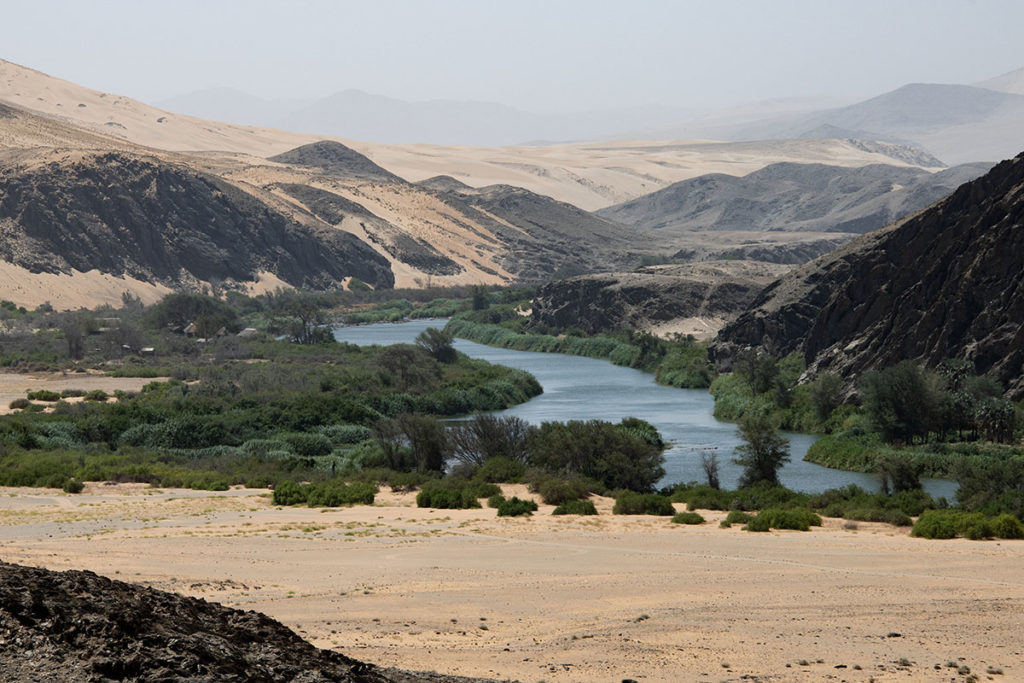
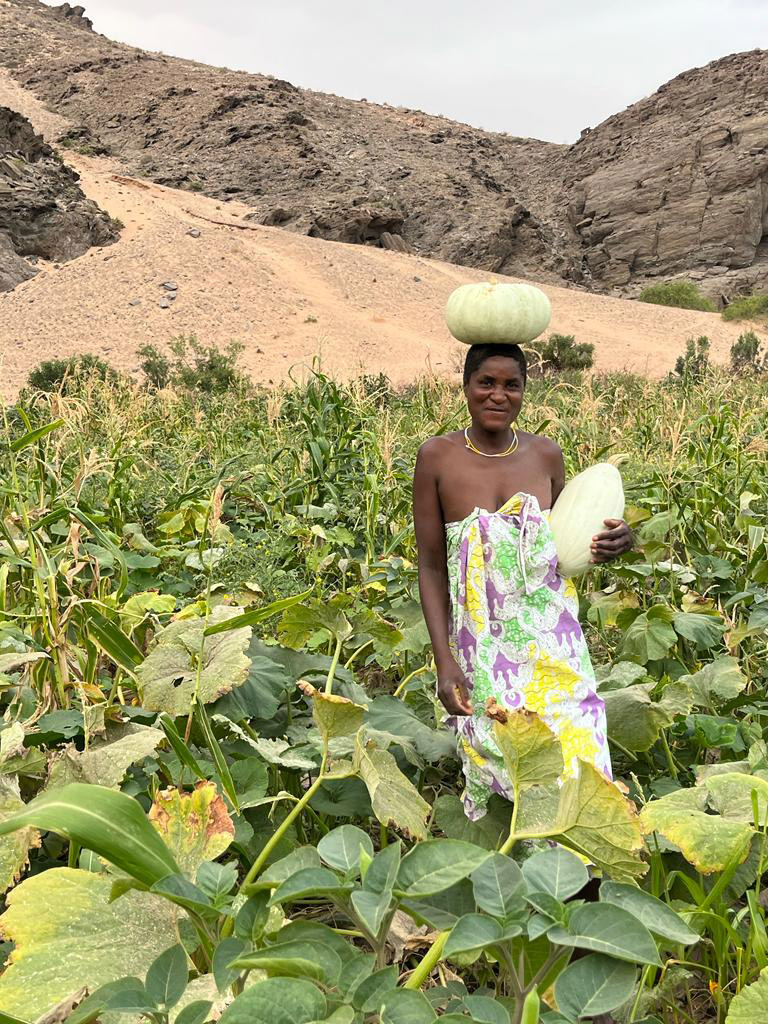
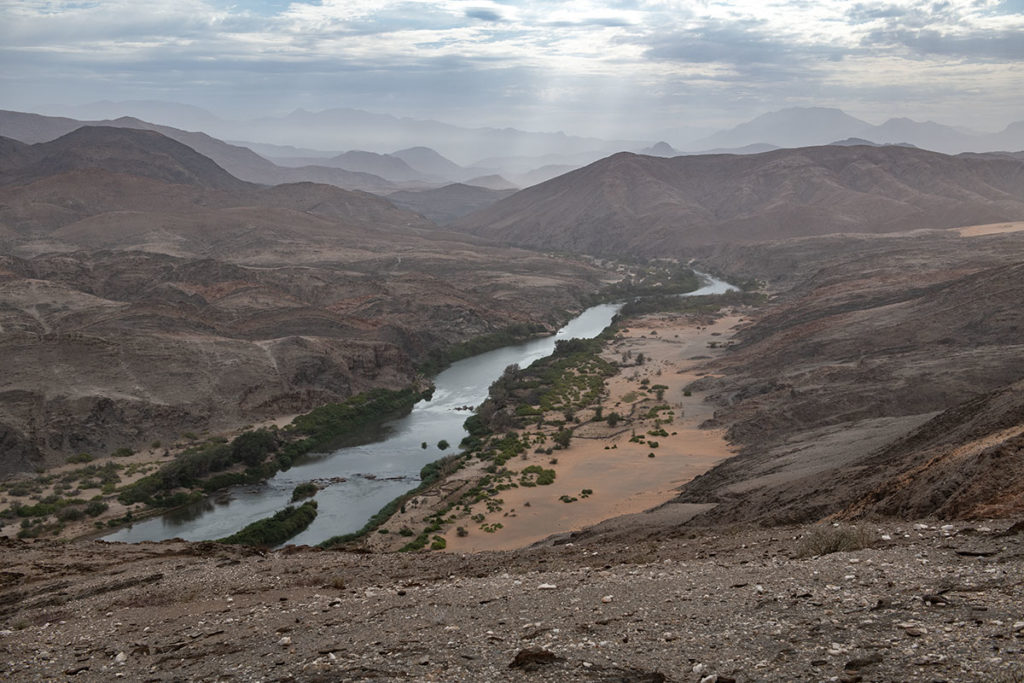
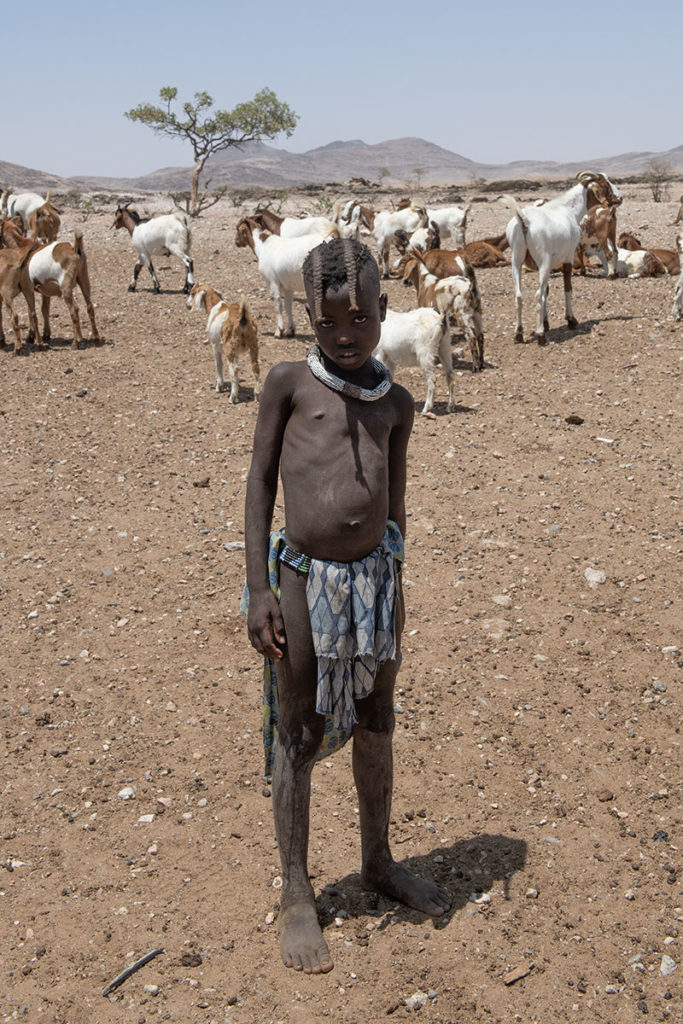
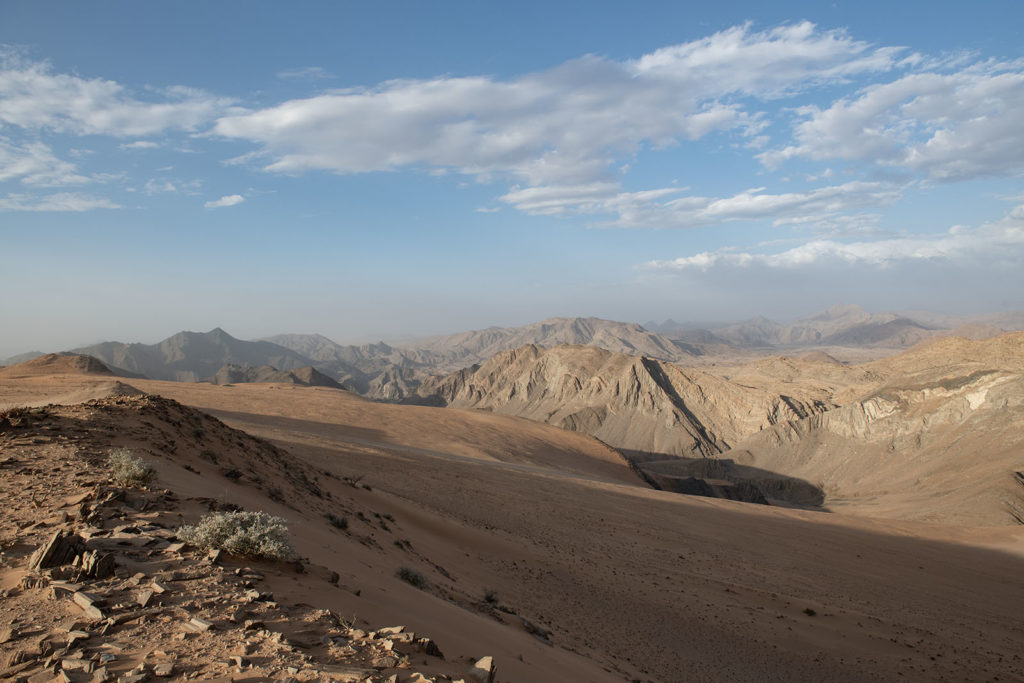
Himbas
In this isolated region, only the nomadic Himba tribes can be found. Unlike many other areas in Namibia, people here still largely live according to their age-old traditions and customs. Namibia has about 15,000 Himbas and just under 5,000 live in neighboring Angola . Their villages, which consist of mud huts and stockyards, are located on higher ground. They are afraid of crocodiles and therefore do not live near the river.
Water pumps
Some tribes live deeper in the valley and have less contact with the visitors of Wilderness, such as the family of our interpreter Ricardo. About 500 people live in the desert of Marienfluss and are supplied with water by their cattle. Since 2002, Wilderness has been investing in underground water pumps and solar panels, which have also been installed here. People from all over the region come here. In drier times (2015-2018), many livestock died despite the water supply. Still, people are happy with the pump; it makes a big difference to them and makes life in the desert a lot easier. ->>
On arrival we see a herd of cows quench their thirst at a large watering hole. When they have finished drinking, a herd of goats sprint towards the bin. Finally, the sheep and the donkeys are next. It is a comical sight how the animals neatly wait their turn.
Moro moro
The families are not active. It’s way too hot in the middle of the day, so they laze around and chat. Some women sit in a circle under a tree chatting with their babies and toddlers or taking a nap. Moro Moro (hello, how are you?), it sounds. The women loosen up a bit and later start dancing spontaneously when they notice that we are genuinely interested. It remains special that these people are satisfied with so little. It is a stark contrast to the luxury of Wilderness, but at the same time the Himbas would probably already be completely modernized if there was no small-scale tourism in this region, because without water they cannot survive.
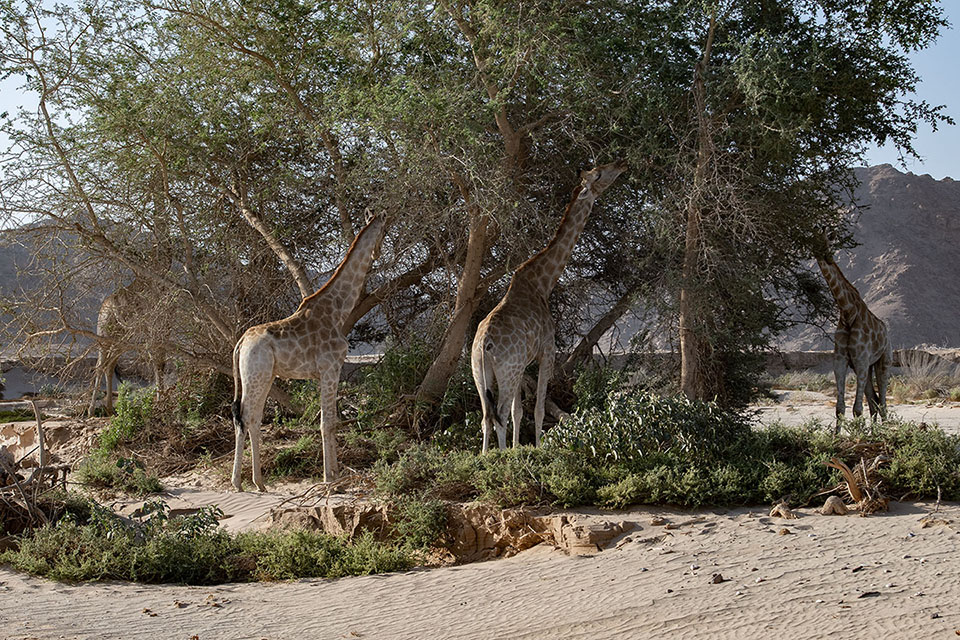
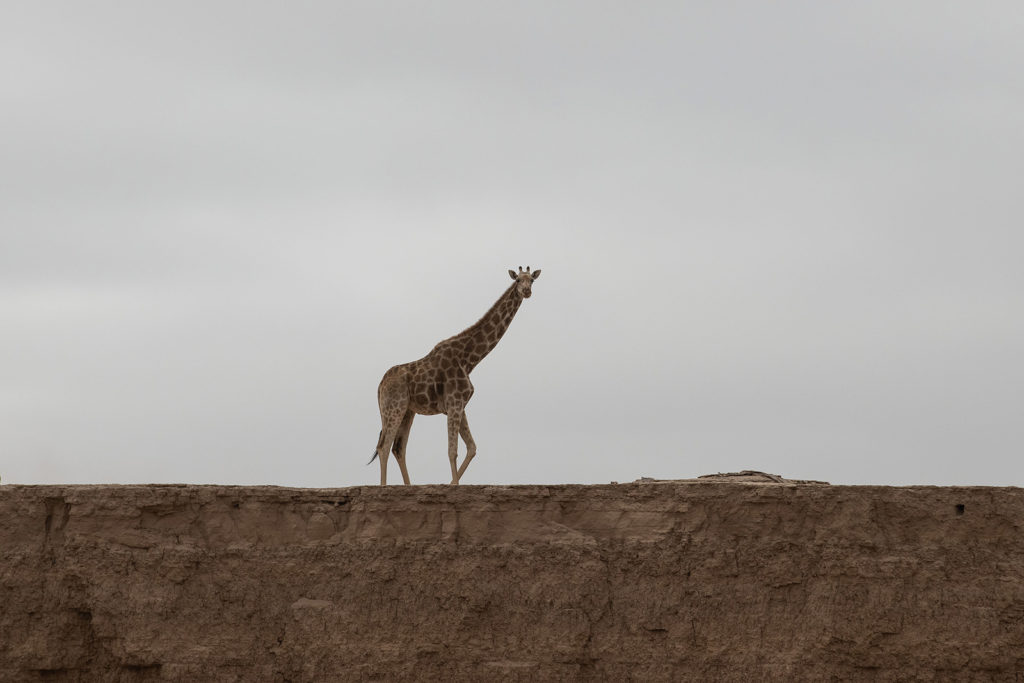
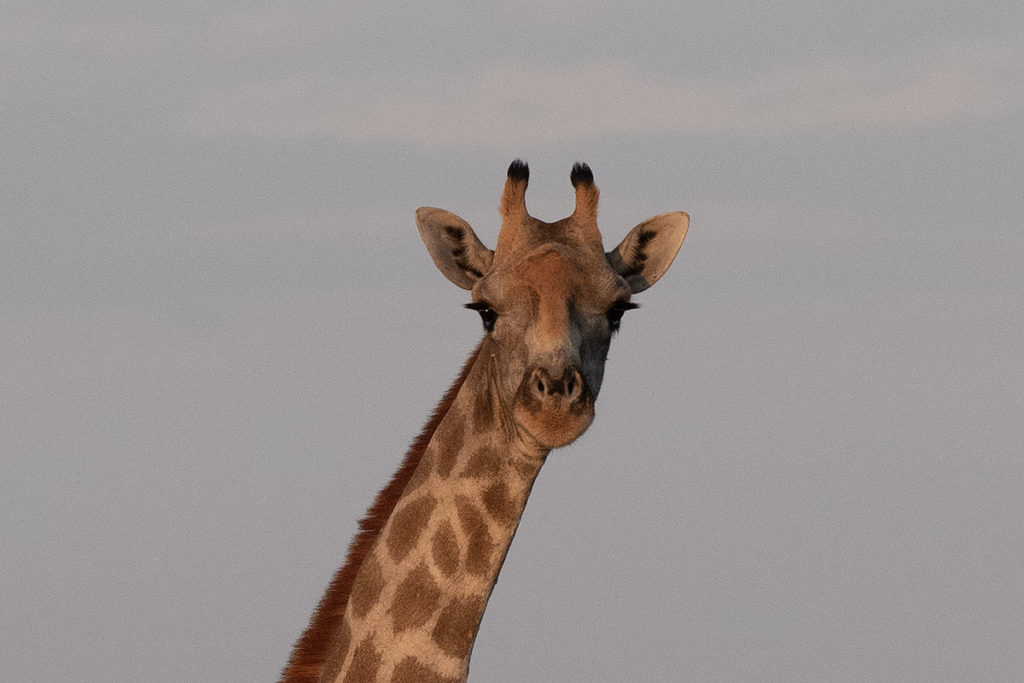
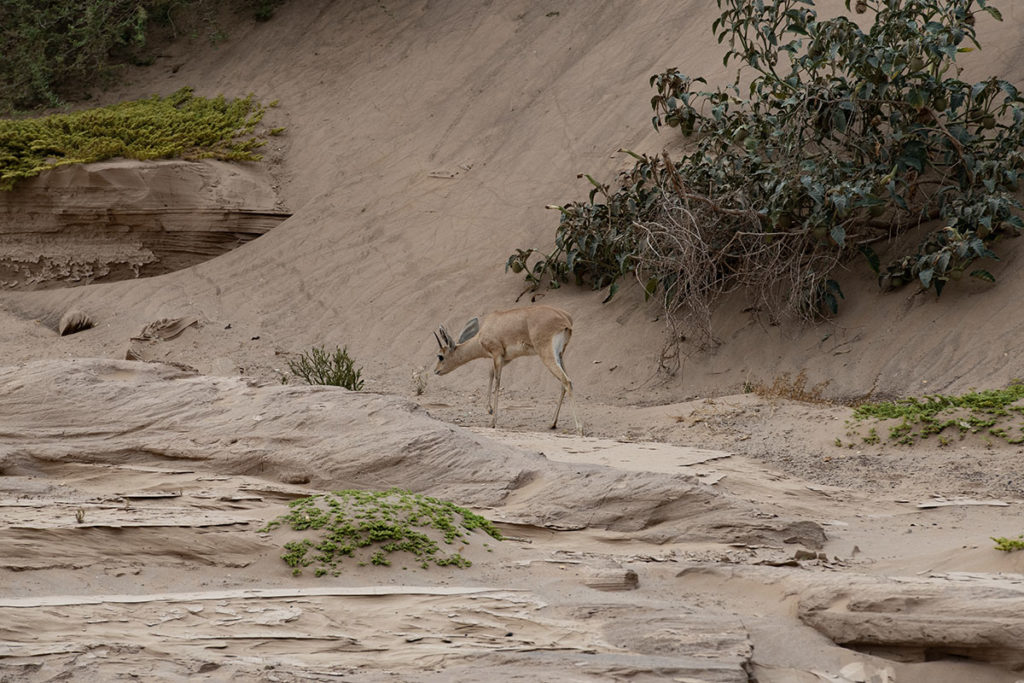
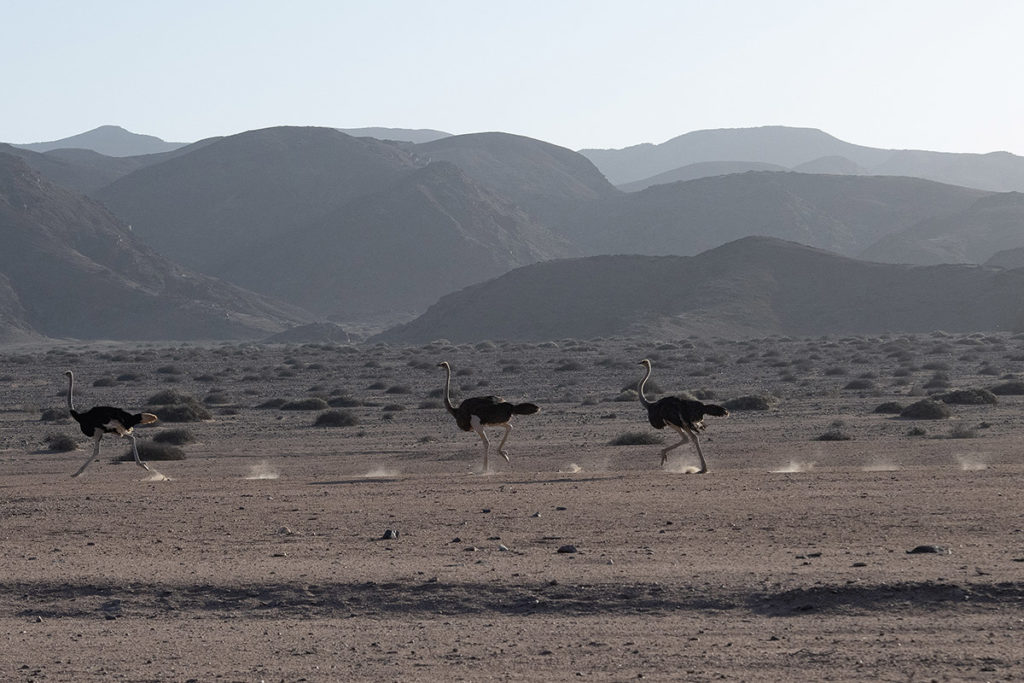
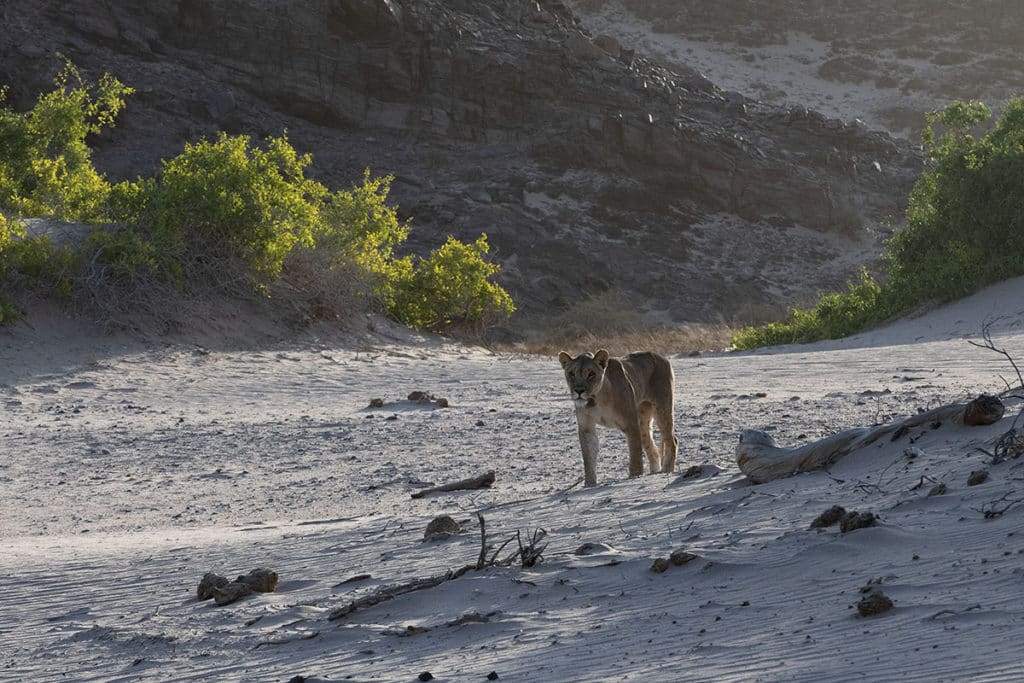
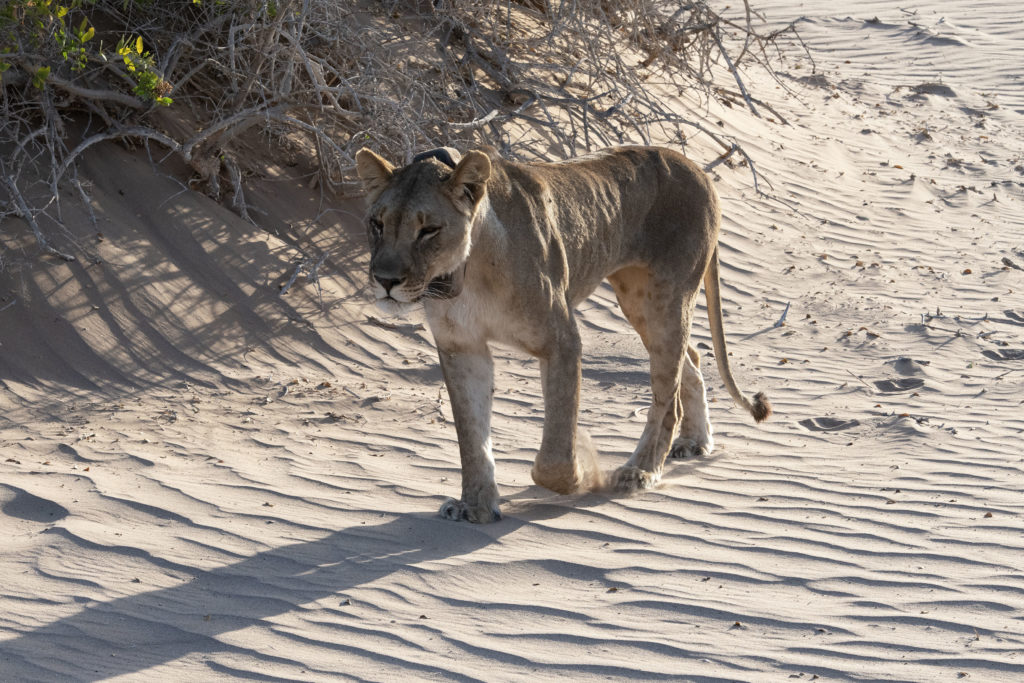
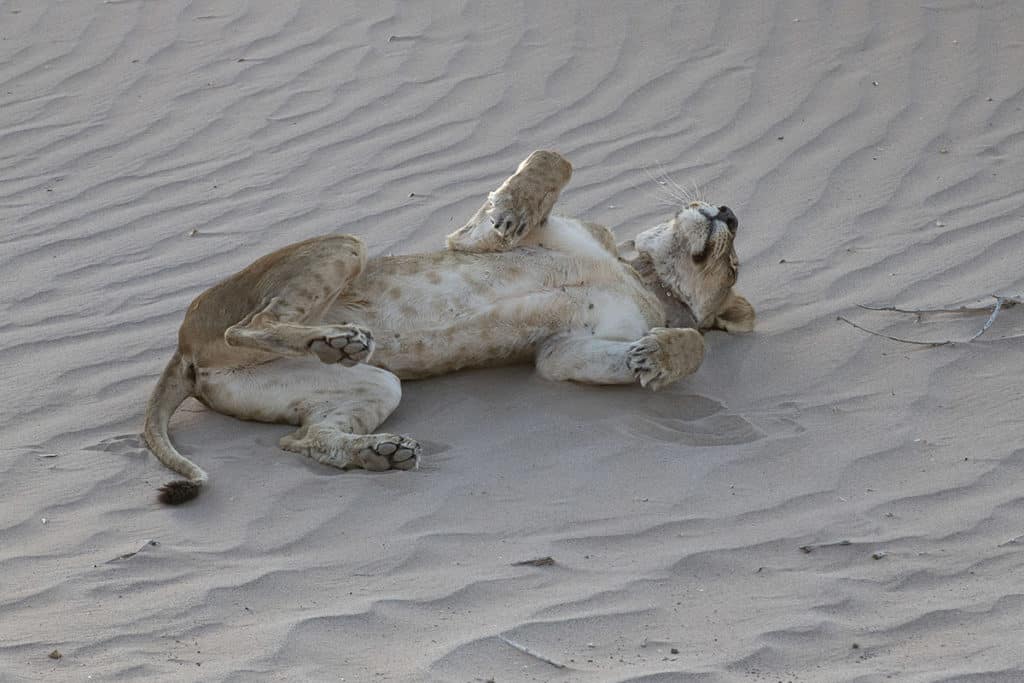
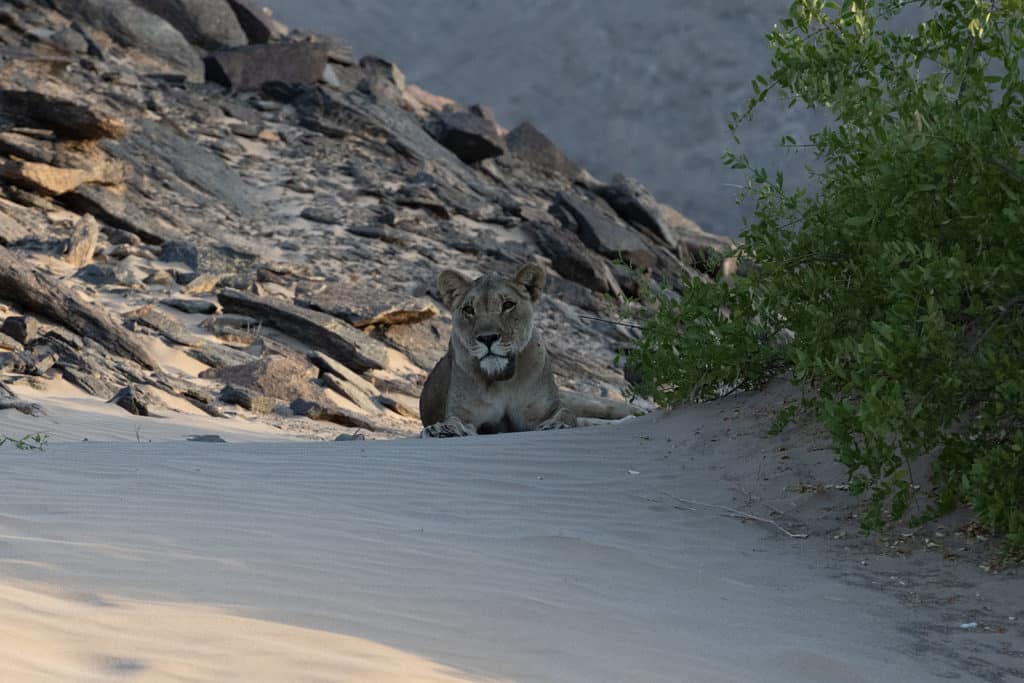
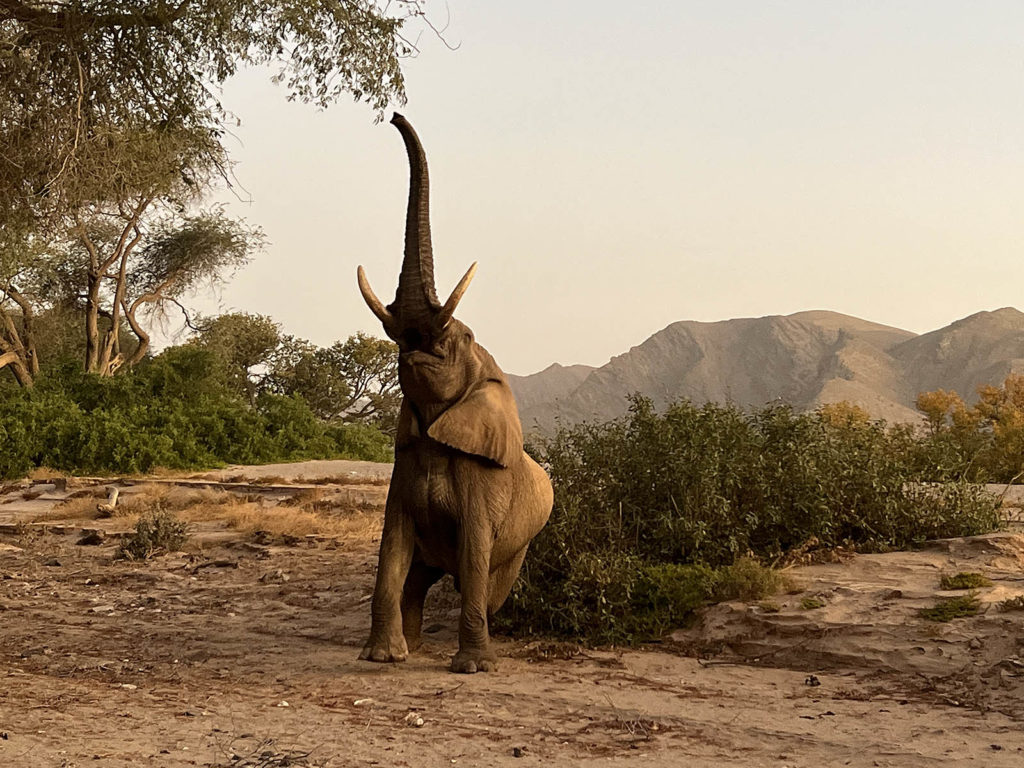
Hoanib Skeleton Coast
We conclude this crazy journey with the equally isolated Skeleton Coast and the adjacent Hoanib River, which covers 270 kilometers. The river – which is dry most of the year – connects Kaokoland and Skeleton Coast. The Skeleton coastal strip is no less than 500 kilometers long and 40 kilometers wide. This area is notorious for the rough sea, the cool mist and strong wind currents that are often caused by the Bengula current. Thousands of ships have been sunk. The pristine, raw area has 350,000 hectares of land. And home to 75 percent of Namibia’s endemic species of mammals that have adapted to the deprived desert.
Desert lions
During our first long game drive, there are surprisingly many animals around the dry Hoanib River. We spot towers of giraffes (more than five specimens together), various antelopes, the rare desert elephants – which shuffle very close to the cars – and…. lioness Charlie who is diligently looking for food. She looks emaciated and has quite a few scars on her body. But Charlie is a good fighter and resilient. She also wears a collar. Charlie is one of the rare desert lions found only in Namibia. Dr. Phillip Stander and Dr. Emsie Verweij closely follows her and others through transmitters. Philip in particular has devoted his life to the protection, monitoring and scientific behavioral research of the lions since 1997.
Ghosts of Namibia
In the early 1990s, the desert lions were little more than ghosts. They had almost completely disappeared. Exterminated and perished by the harsh living conditions. However, in the late 1990s, Philip found a pride of lions deep in the bush and decided to study them from then on. More than three decades later, partly thanks to Philip’s groundbreaking research and the support of Wilderness, among others, the population has increased to 80 to 100 lions. There were many more, but many of the big cats have died during the pandemic from poisoning or exhaustion from drought and lack of food. The number of human-animal conflicts is also increasing. The future of the lions is worrying. To be able to see a desert lion like Charlie up close makes a deep impression. ->>
Vanishing Kings Foundation
Dr. Philip Stander has released a beautiful book together with the film couple Will and Lianne Steenkamp: Vanishing Kings, Lions of the Namib Desert . Lianne is originally from the Netherlands. Two award-winning documentaries have also been published about it. The third film – starring Charlie, among others – is in the works and will be released in 2024. In addition, they jointly founded the Vanishing Kings Foundation , where Wilderness also contributes financially to research equipment to monitor the lions as well as possible.
The brown hyena
Emsie Verweij has specialized in brown hyena research since 2013. This is the first official density survey for brown hyenas in Skeleton Coast , in collaboration with the Department of Environment and Tourism. Wilderness also supports her with equipment and facilitates her stay and workplace. Emsie gives a lecture to guests and, on request, she takes interested parties on a tour.
Skeleton Coast day trip
A day trip to the coast by off-road vehicle provides a truly unforgettable experience due to the ever-changing landscape and the many animals we spot along the way. From the lively Hoanib bed it is a 45 kilometer drive to the Atlantic Ocean. Here, large green plains, rugged rocks and huge sand dunes and extensive coastlines alternate. Totally unexpected we come across a beautiful lush oasis, in the middle of the dune area. Sitting in the sand, musing in thought, we continue to marvel at this inhospitable land.
When we end our day with a delicious home-cooked beach lunch, after a visit to noisy Cape fur seal colony and their newborn helpless cubs, the feeling of complete satisfaction overwhelms. Hypnotized by this mysterious landscape, time seems to stand still. This is the ‘real’ Africa: no stress, no agenda, no obligations. In Namibia, the soul comes to rest. ![]()
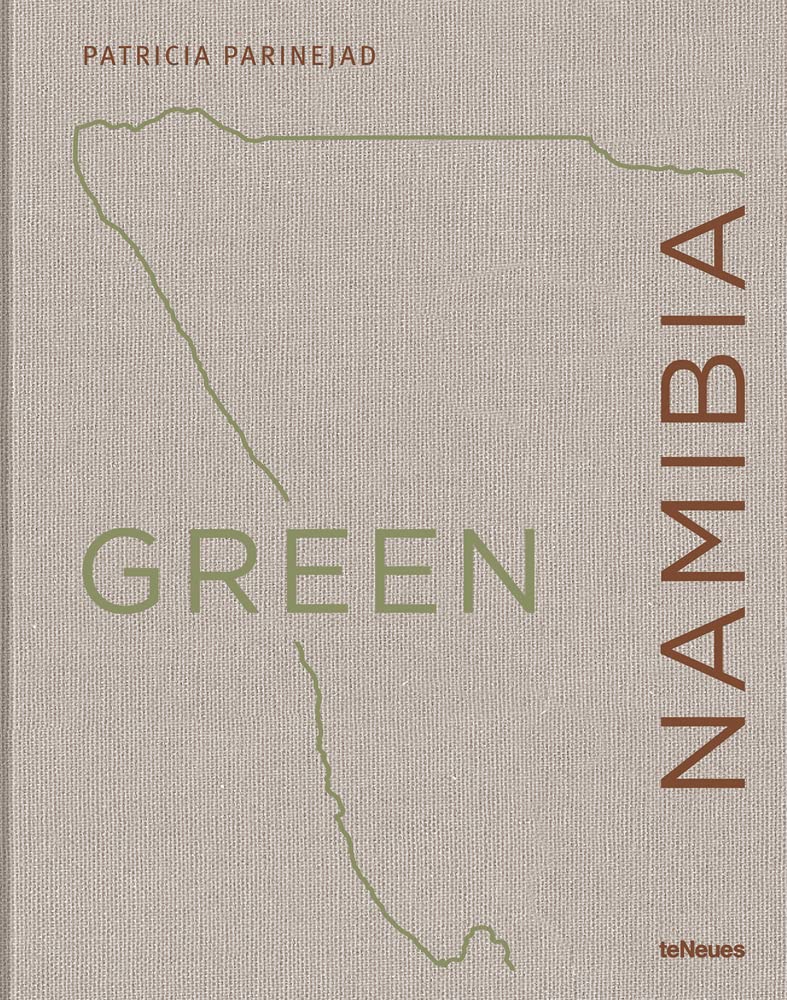
The new book, Green Namibia (teNeues) by Patricia Parinejad was recently published. In this coffee table book, the photographer and author presents how different activists and organizations within ecotourism are committed to nature conservation, sustainability and working with local products. They try to reduce their ecological footprint as much as possible. An intriguing topical book.
Price: 60 | hardcover 23.5 x 30 cm / 9 1/4 x 11 4/5 in. | 224 pp. |
English German
ISBN 978-3-96171-441-4
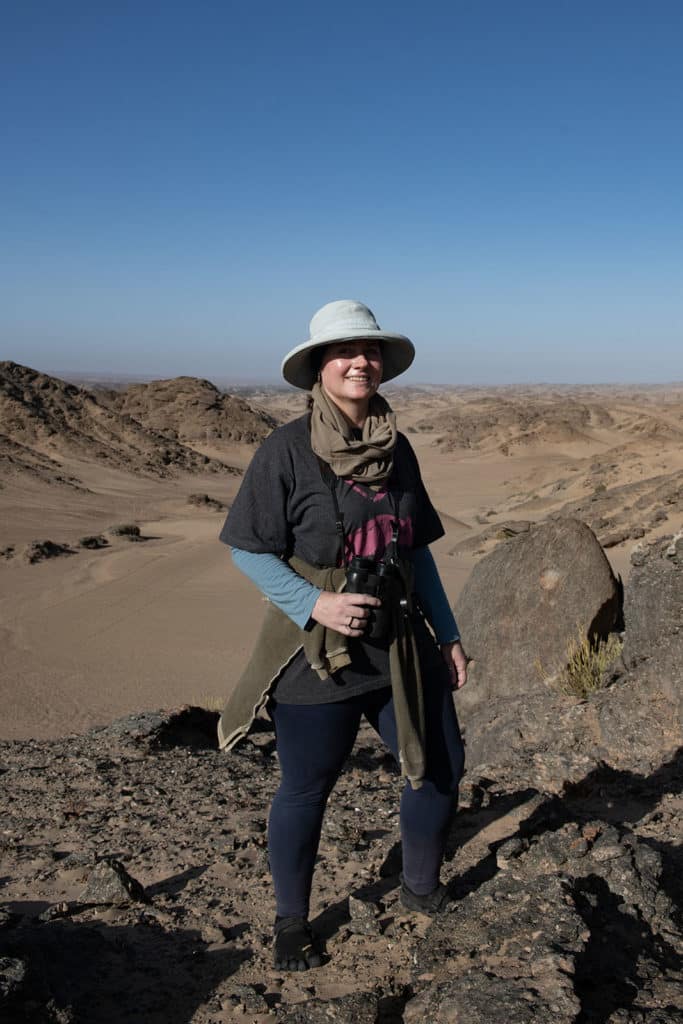
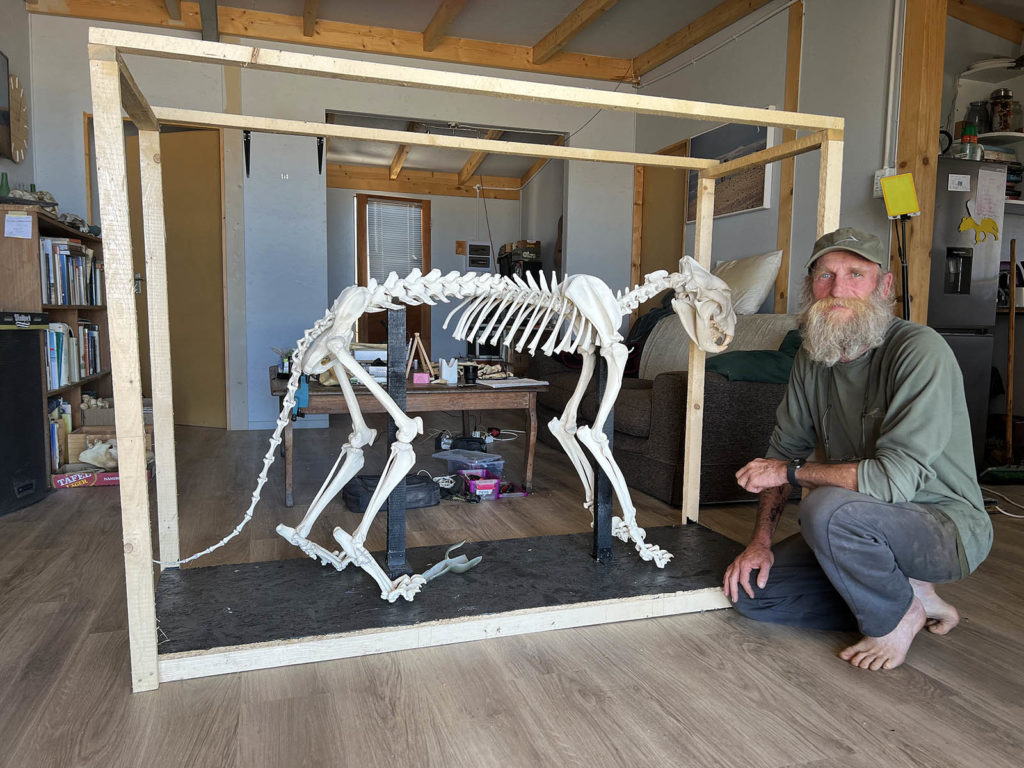
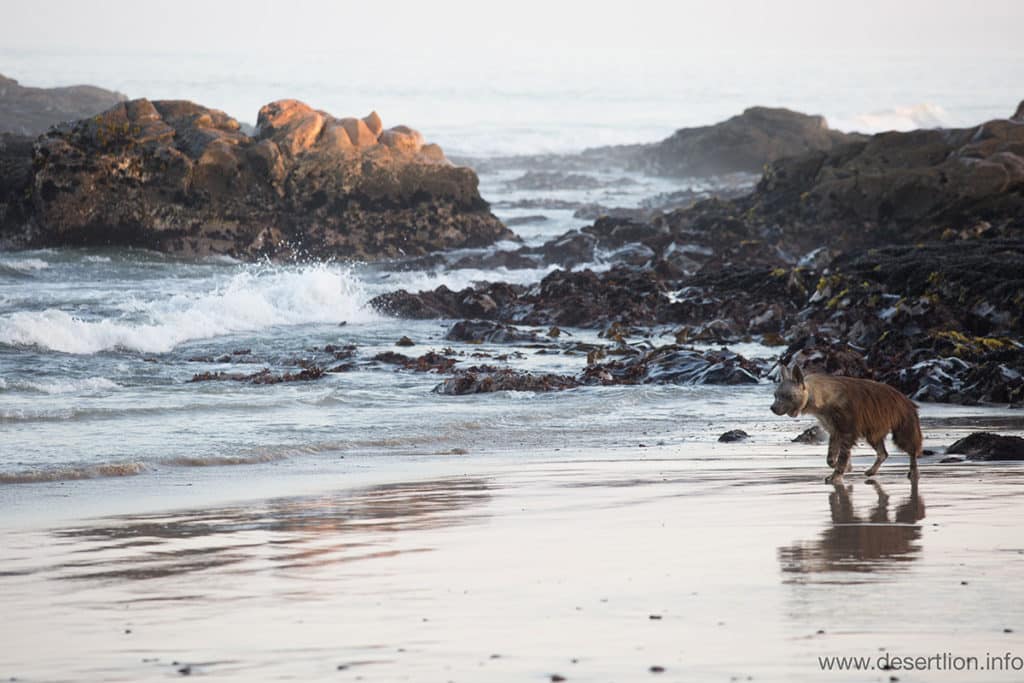
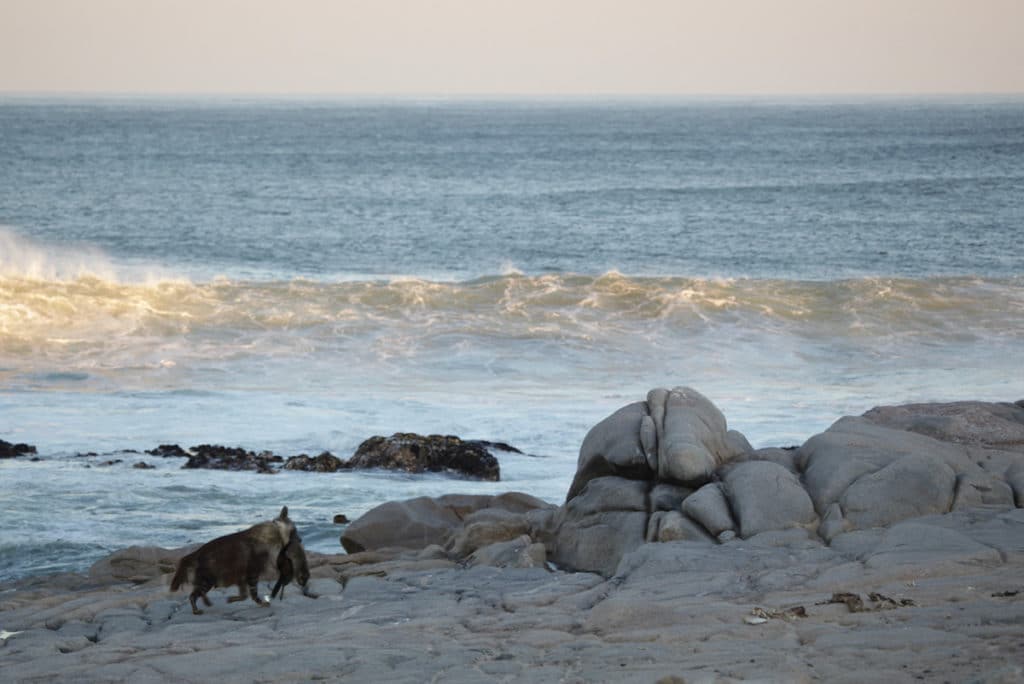
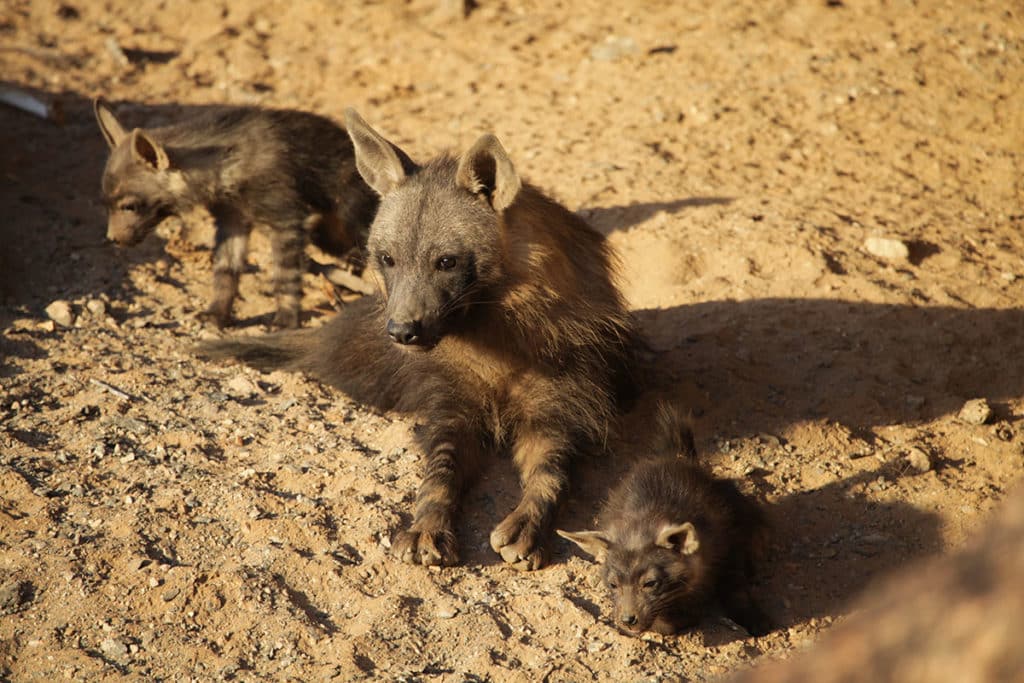
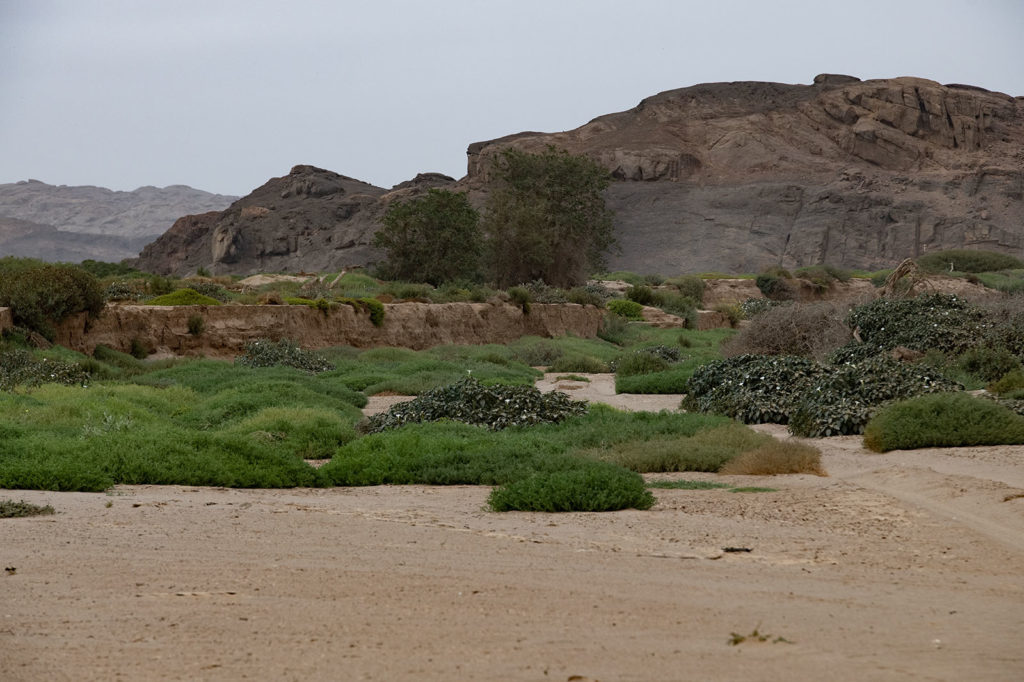
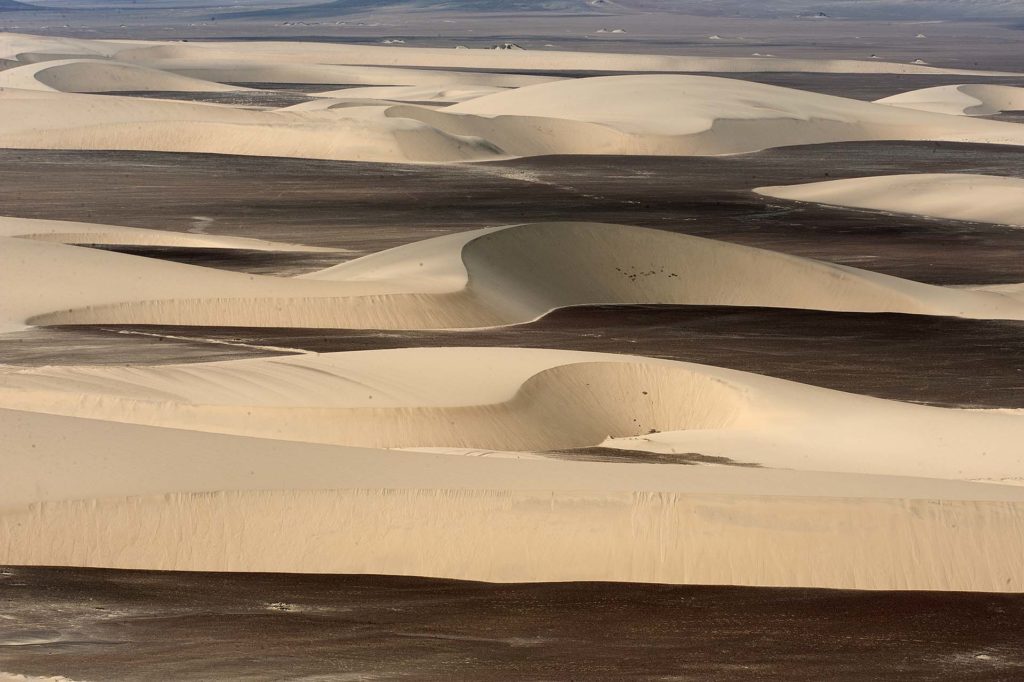
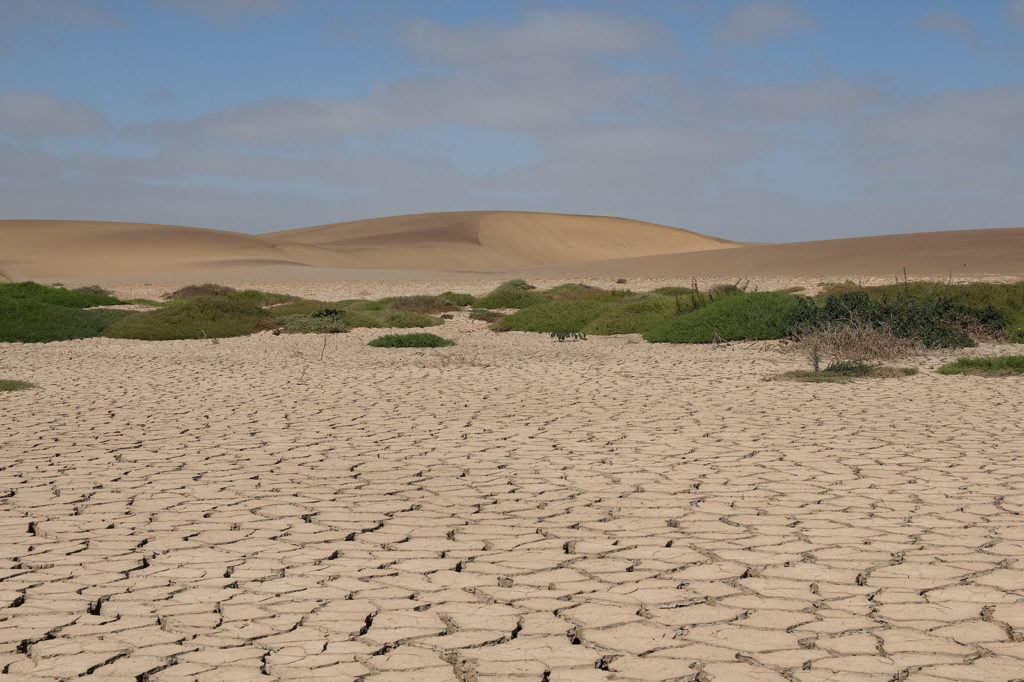
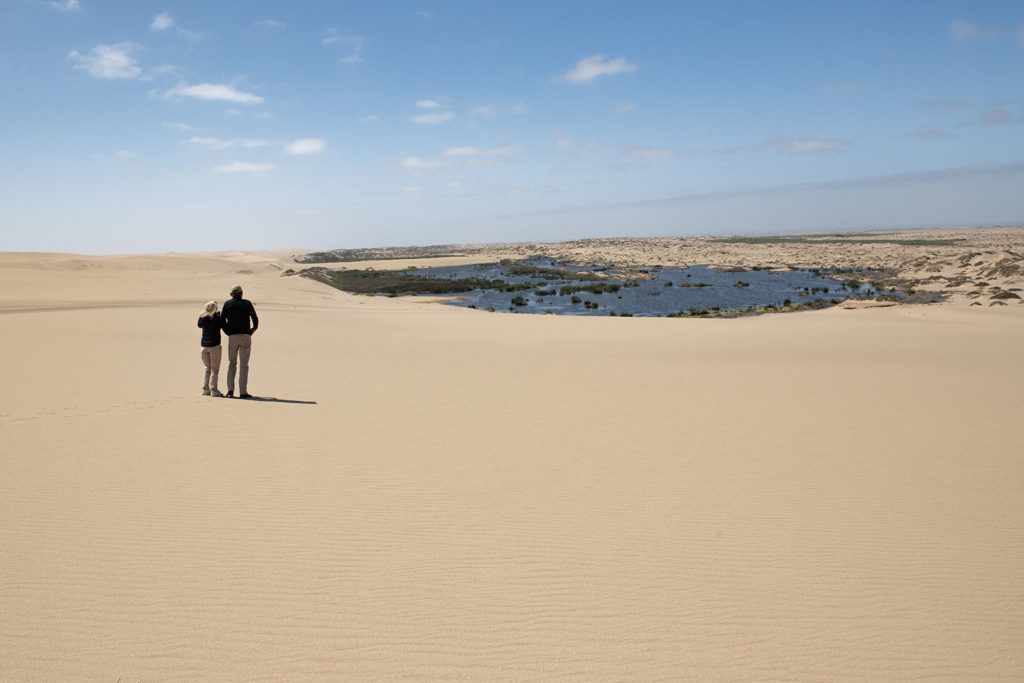
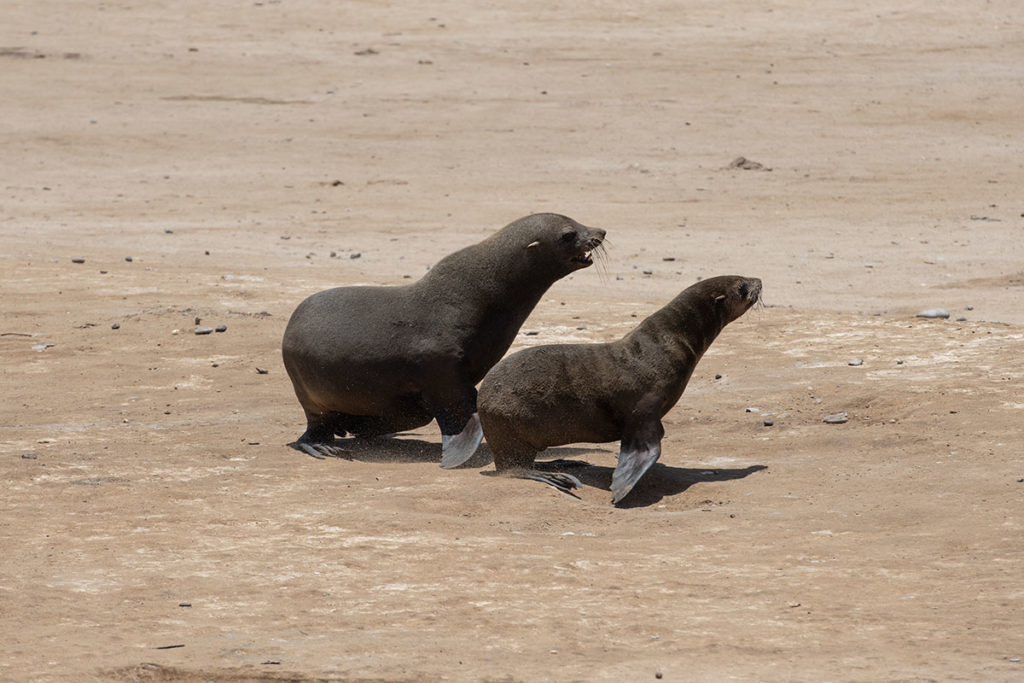
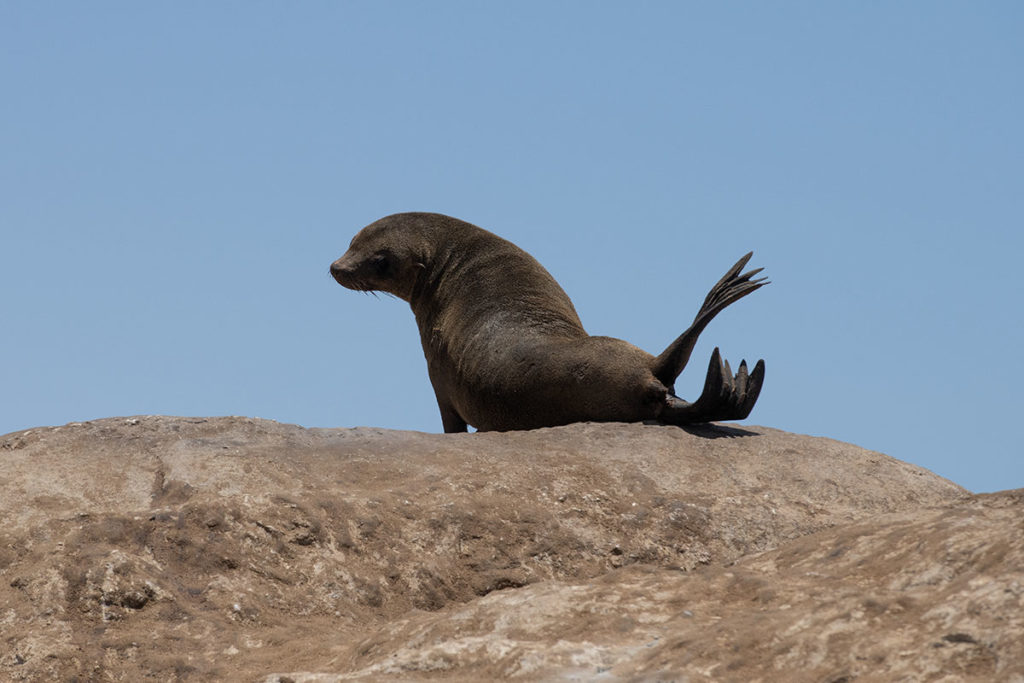
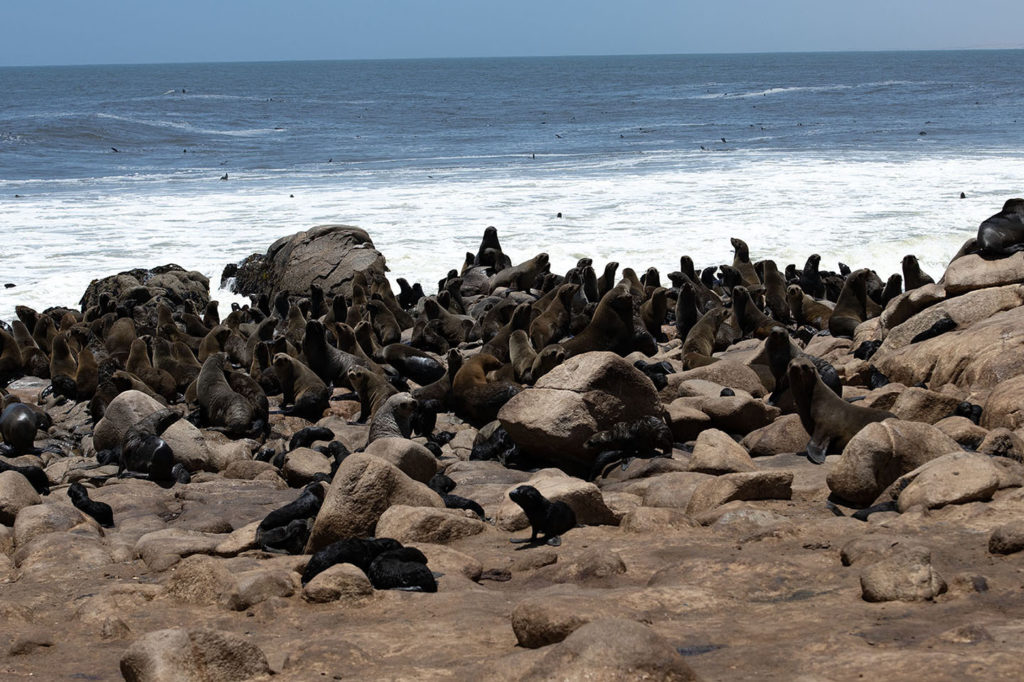
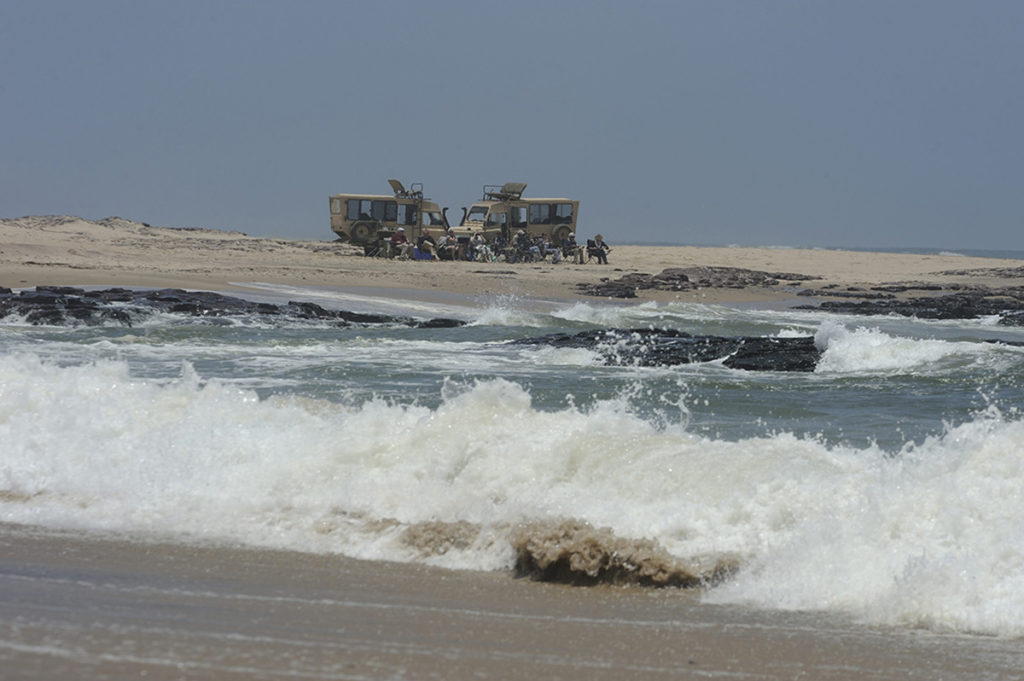
Background Wilderness
Wilderness has been focusing on nature conservation, sustainable tourism, research, education and high-quality service in their exclusive lodges for years. The luxury is not only in the really beautifully decorated tents and lodges, everything fits perfectly in style and ambiance with the impressive landscapes. In addition, the guides have a great deal of knowledge about nature and are excellent trackers.
Sustainable tourism
In addition, the travel organization has been committed to sustainable tourism in Southern Africa since the late 1980s with various contributions from the Wilderness Wildlife Trust . The trust focuses on conservation, research, education, running their own anti-poaching management and supporting and involving local communities in their projects. There are dozens of projects that the Trust makes possible. But the relationship is symbiotic: without tourism there is no trust and therefore no conservation.
Stay
The accommodations of Wilderness are truly beautiful and the crew is equally friendly and spontaneous everywhere. The food is of a high standard and is sometimes served in special places. The accommodations are completely integrated into the environment and are all unique and decorated with many natural and local materials. Traveling with Wilderness is an expensive affair, but a stay is all-inclusive (including overnight stays, transport, food and drinks and excursions).
Little Kulala
Little Kulala (Sossusvlei) is all about the luxury of a private outdoor bath, outdoor shower and day bed and beautiful communal space in the middle of the desert. The common area, the restaurant, lounge corner, wine bar and the large terrace look phenomenal.
Desert Rhino Camp
The compact Desert Rhino Camp (Damaraland) exudes more of an adventurous safari feel. The base camp consists of eight exclusive tents, a central dining and meeting place and a cooling small outdoor pool. The highlight is a special bush dinner with neatly laid tables, delicious local dishes and cheerful singing in click language from the employees.
Serra Cafema
A stay at Serra Cafema feels like heaven on earth. Seven luxurious canvas tents with a thatched roof are spacious and very tastefully decorated with natural materials. The accommodations are built on a raised wooden deck, on the sides of the river with a view of the water. And the buildings are connected by wooden walkways that lead to the restaurant, bar, lounge and relaxation area and a small swimming pool.
Hoanib Skeleton Coast Camp
The setting of Hoanib Skeleton Coast Camp is also amazingly located in a desolate rock environment. From the eight large en-suite tents that are really beautifully decorated, and the central reception lodge with outdoor pool, there is a good chance of spotting wildlife. There is a small water hole nearby.
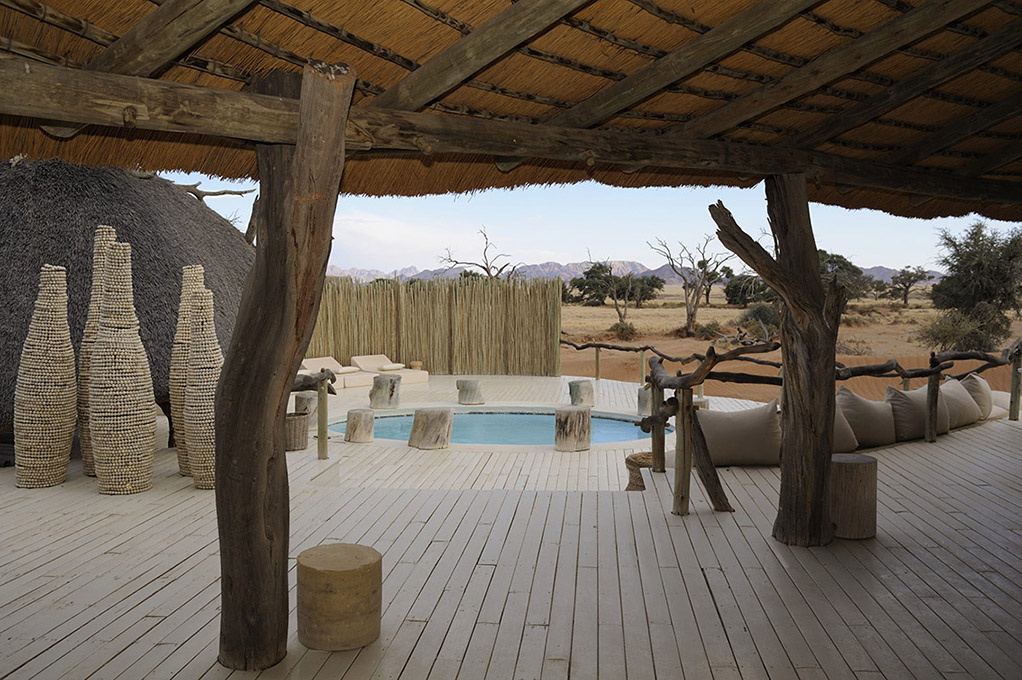
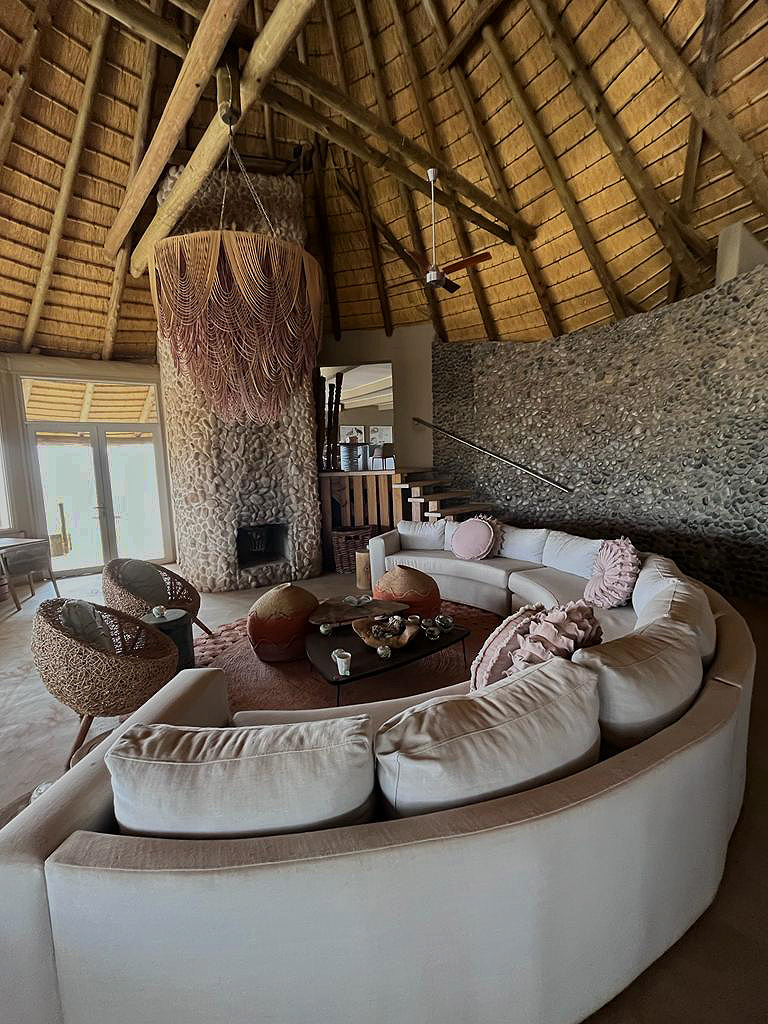
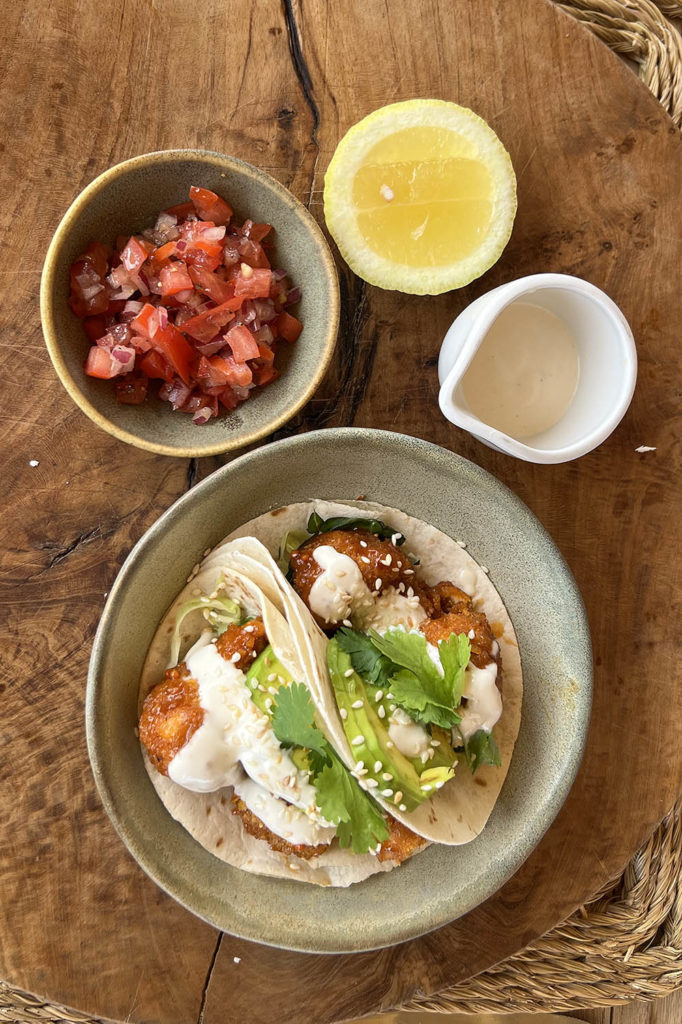
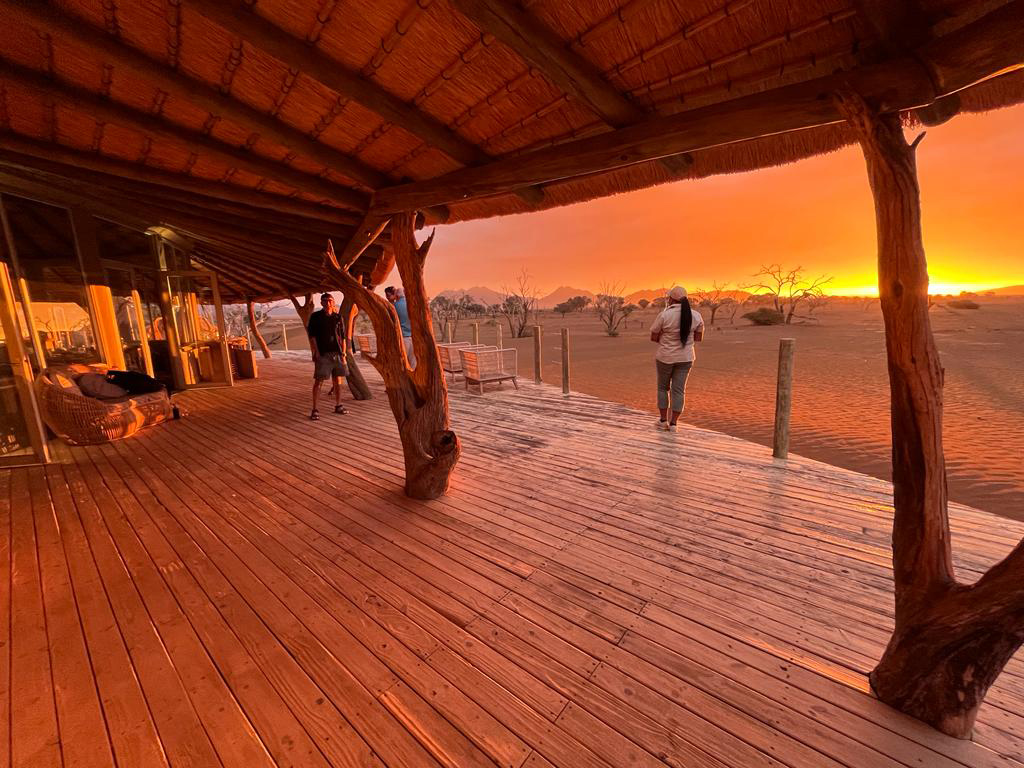
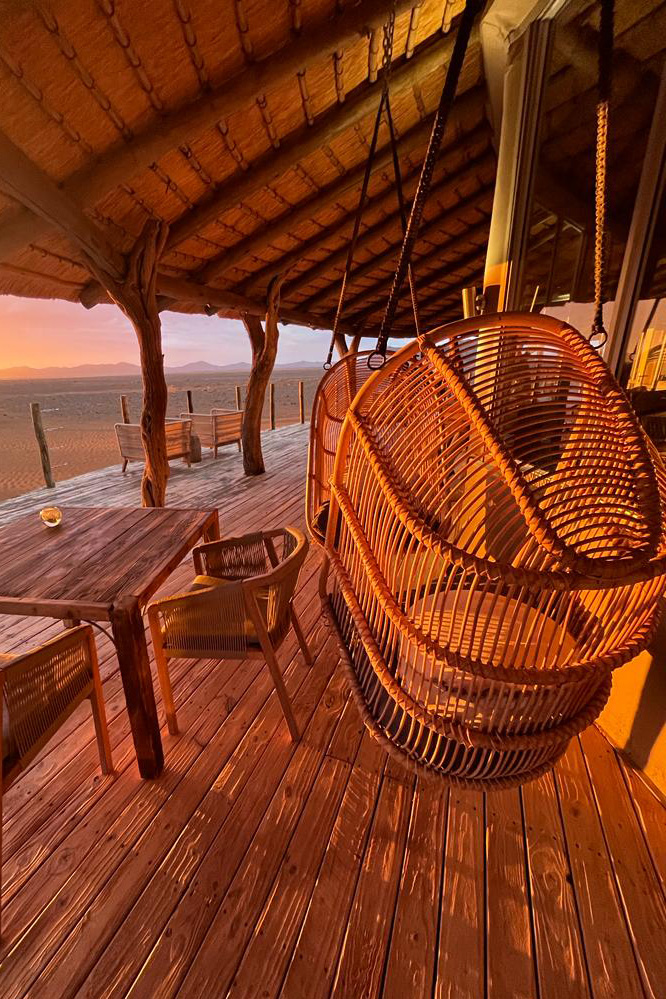
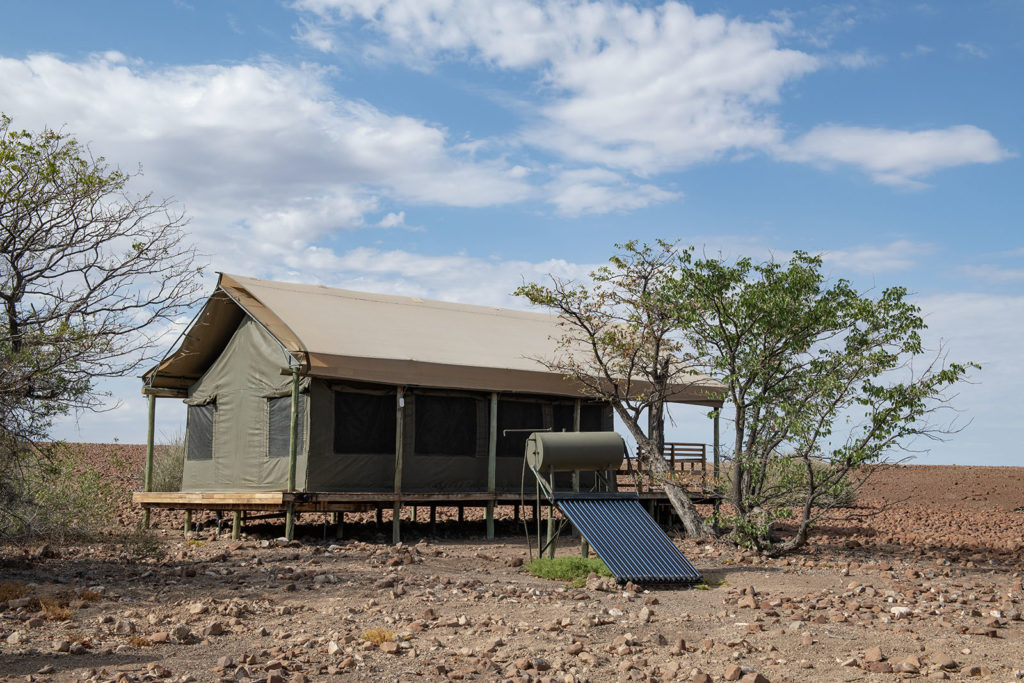
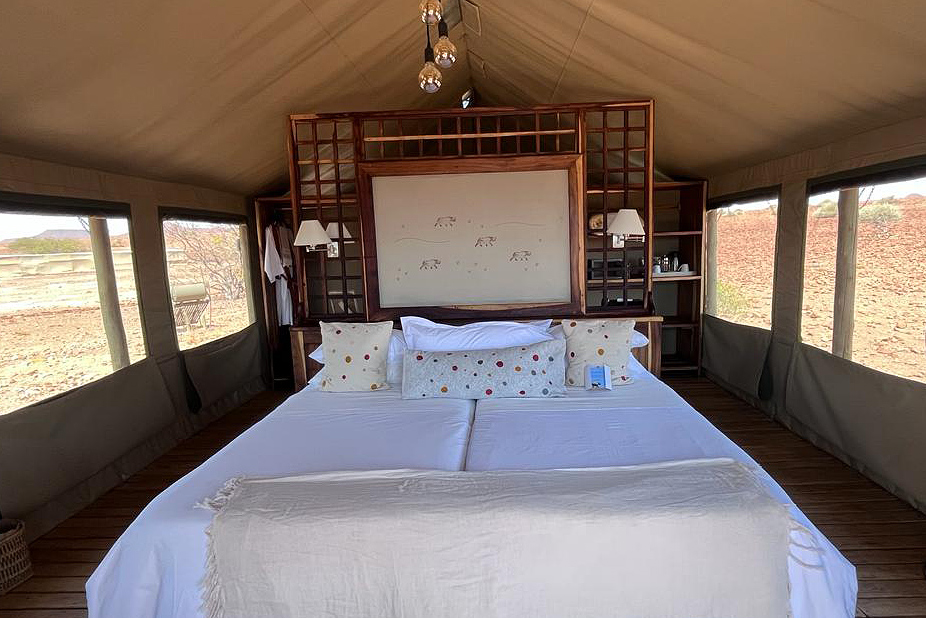
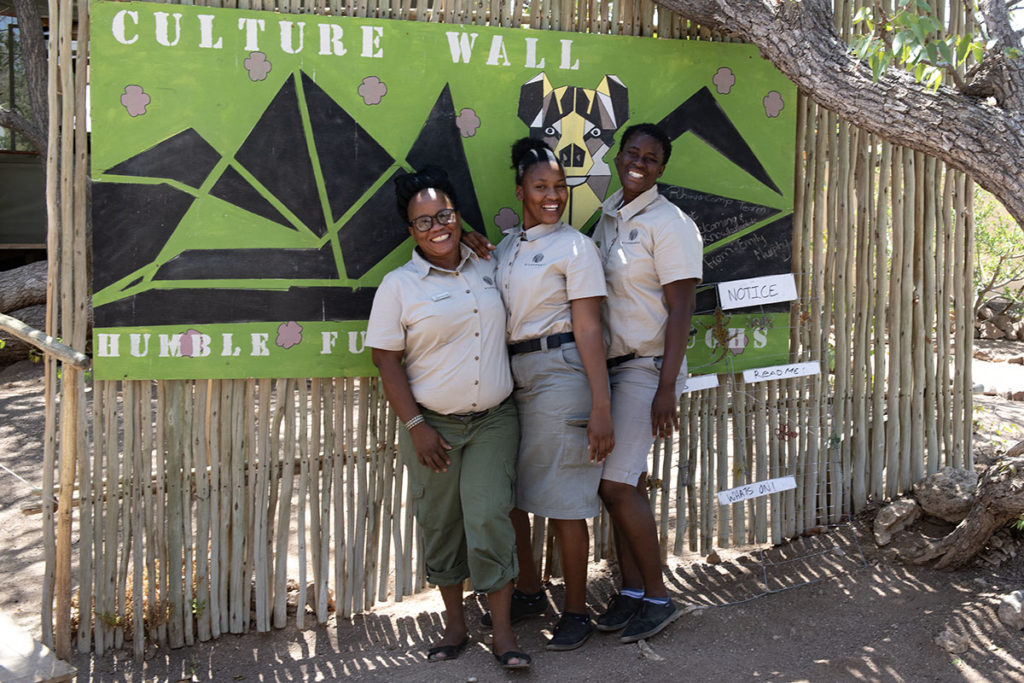
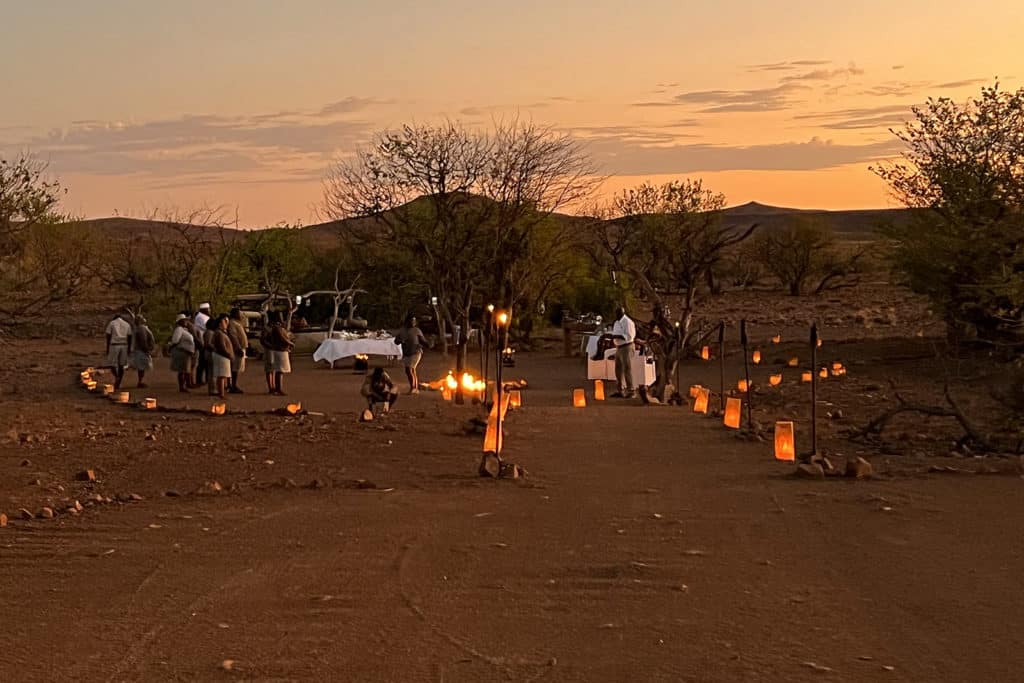
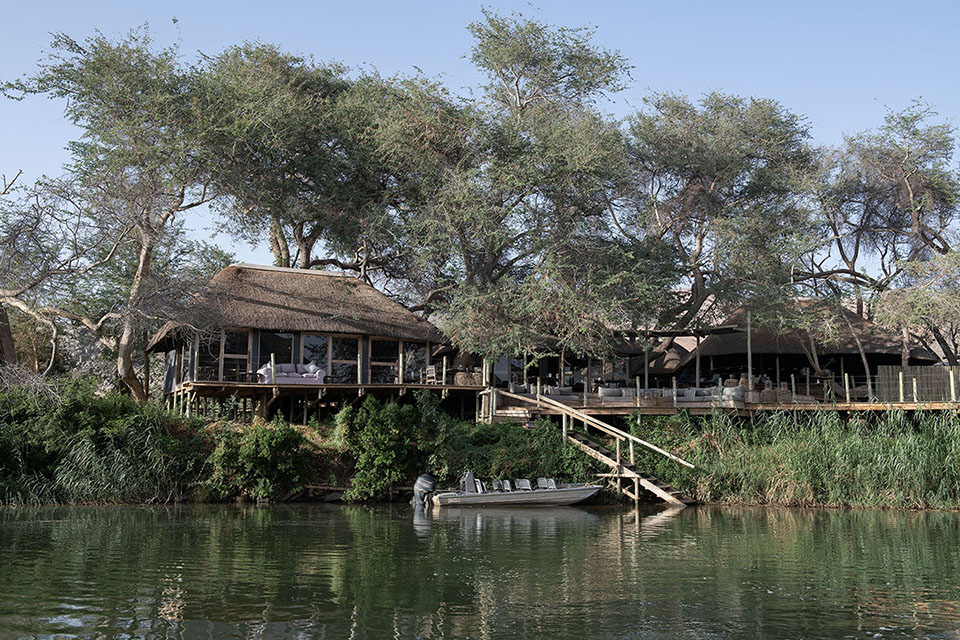
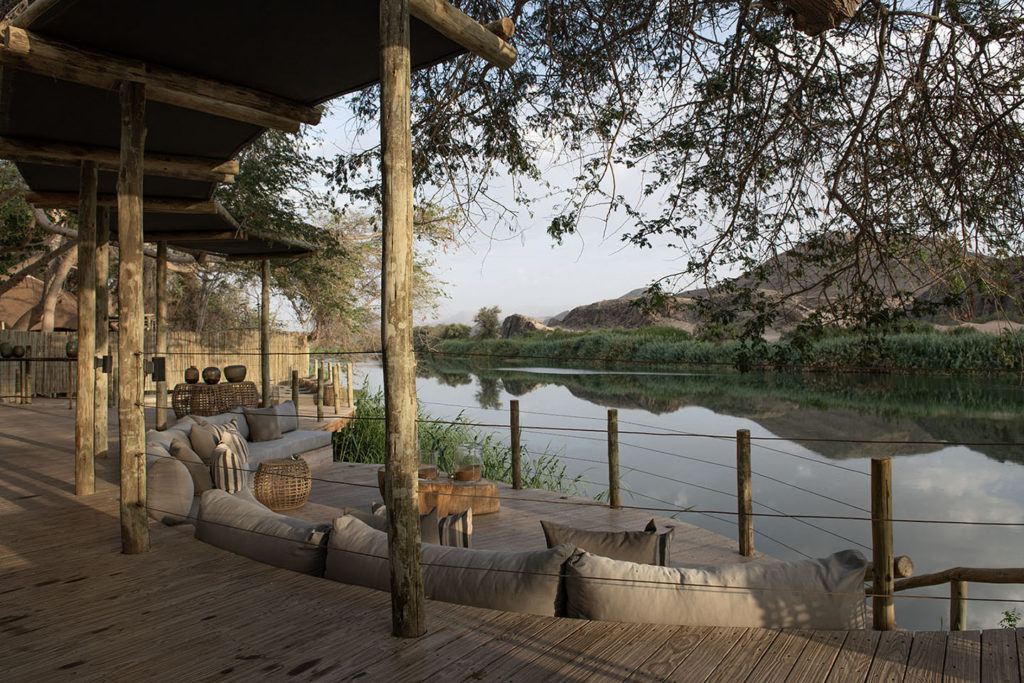
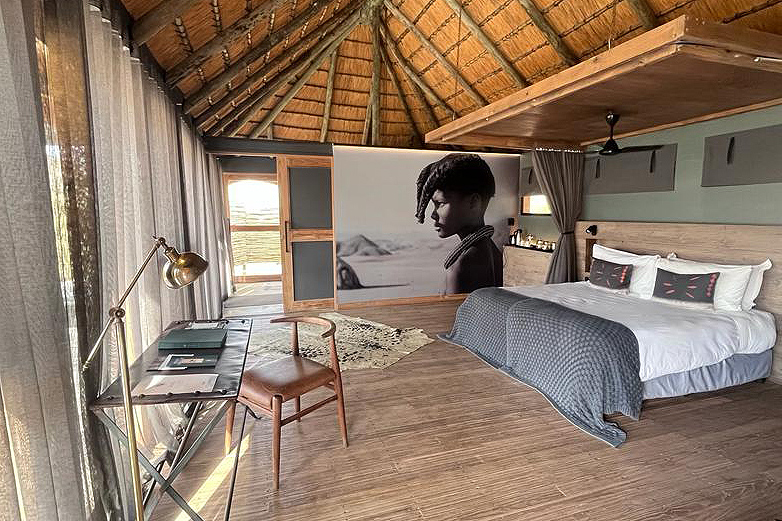
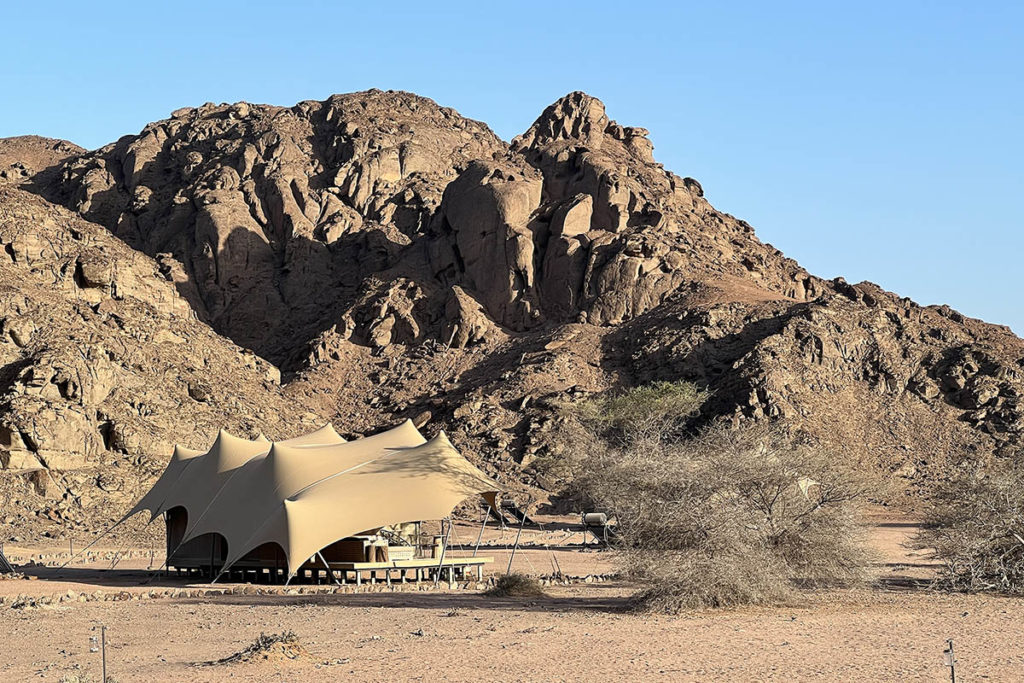
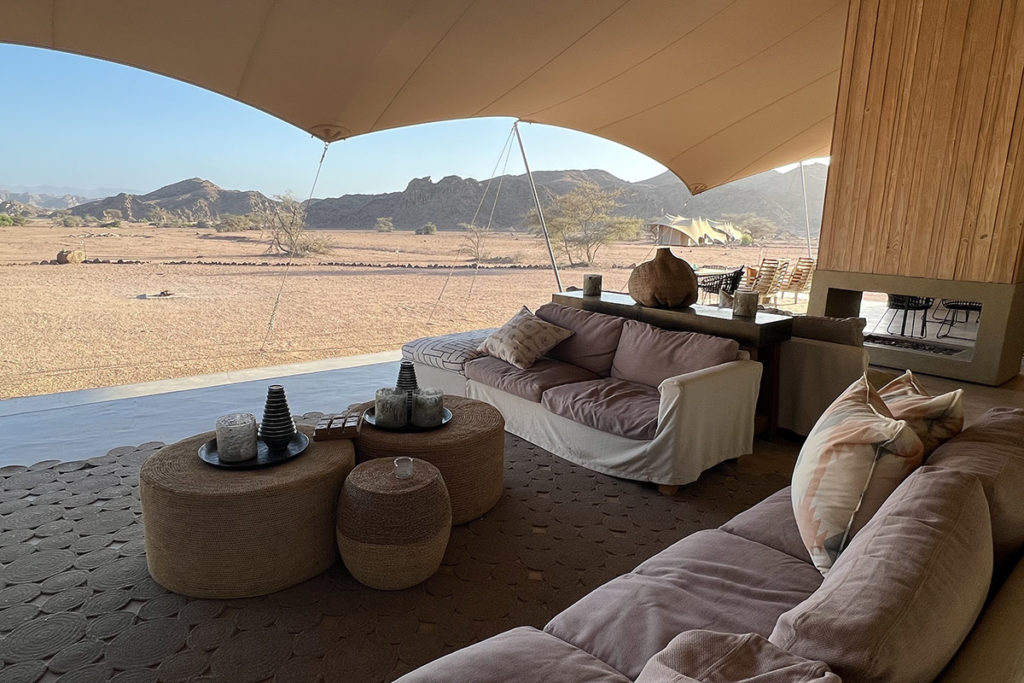
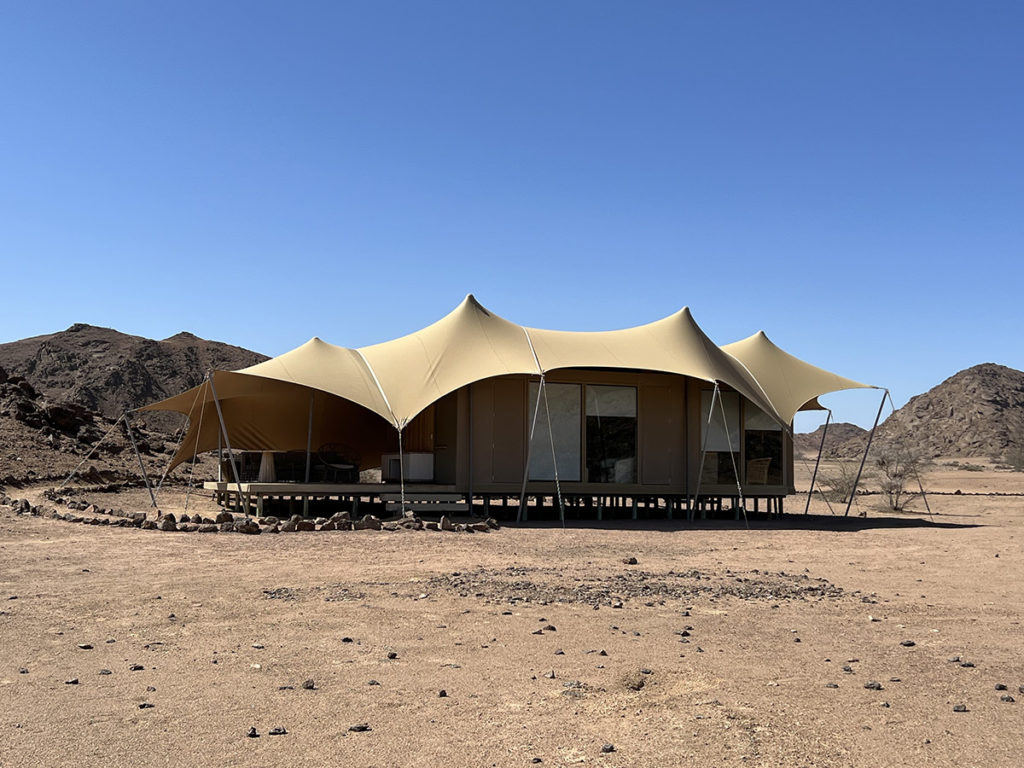
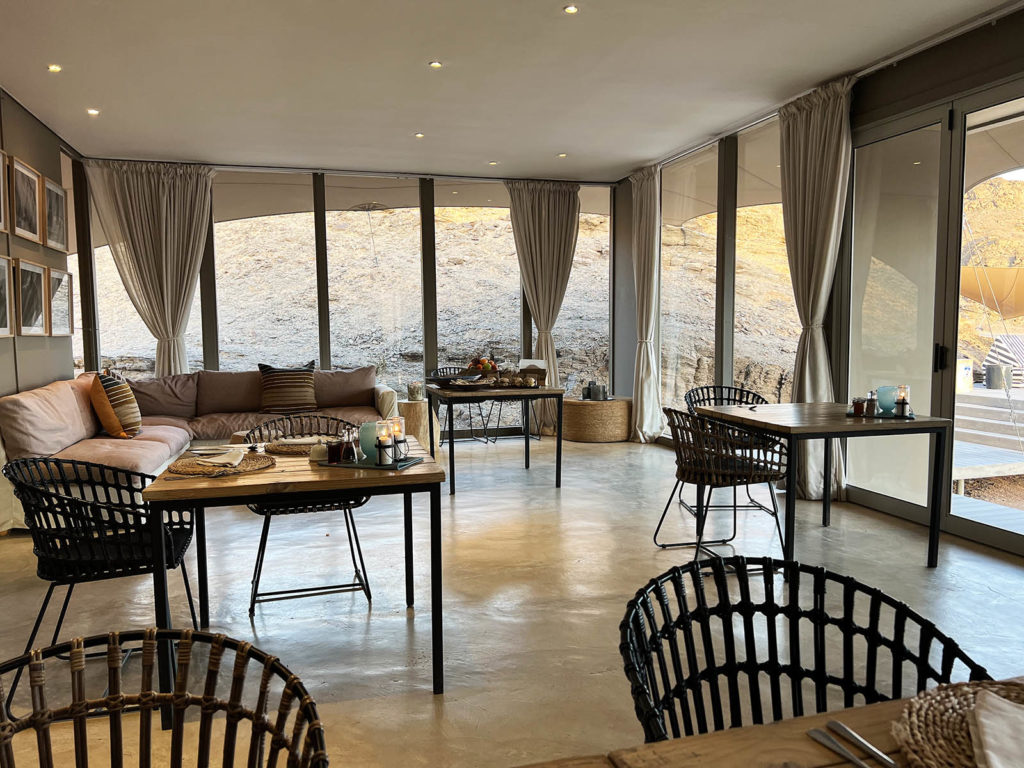
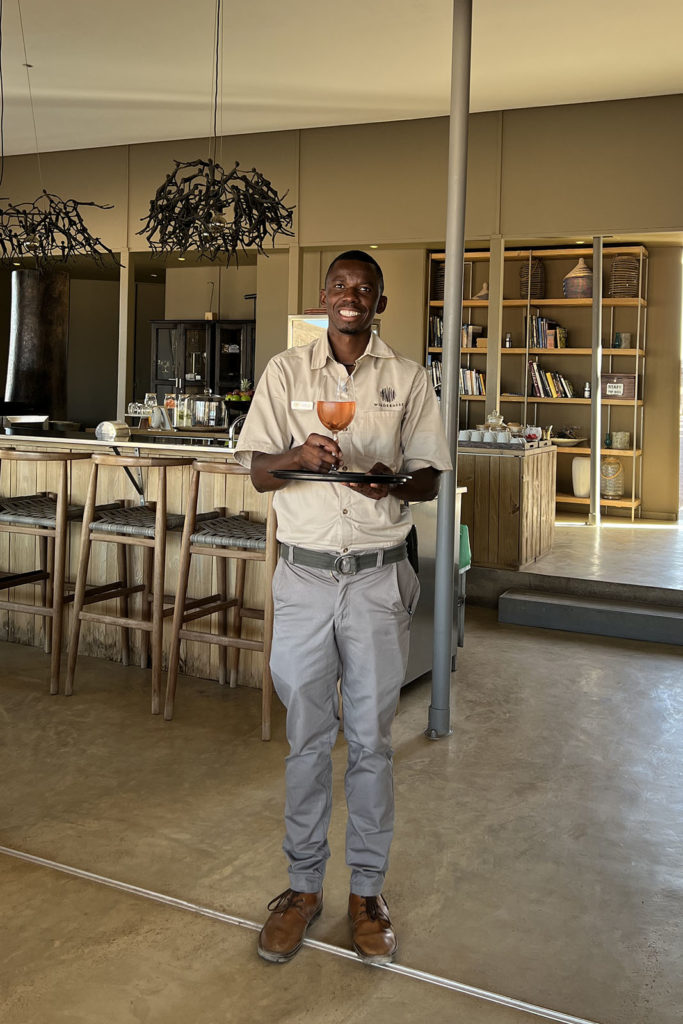
PRACTICAL FRAMEWORK
to it
It is not possible to fly directly to Namibia. Lufthansa flies via Frankfurt or Paris to the capital Windhoek. Various routes are also possible via KLM and Ethiopian Airlines. Tickets vary a lot in price, from 650-2000 euros.
Health
For Namibia it is recommended to vaccinate against DTP (Diphtheria, Tetanus and Polio) and Hepatitis A (infectious jaundice). Malaria hardly occurs in the deserts of Namibia. Before visiting Ethosa wildlife park, it is wise to take malaria pills. For a stay longer than two weeks, inquire at the GGD.
Security & transport
Namibia is known as one of the safest countries to travel in Africa. A fly & drive is a great option thanks to the good road network. Go well prepared with a sturdy off-road vehicle / 4wh-drive car that is in good condition. Spare wheels, spare petrol and possibly an extra mobile helpline are a must for the road, as is, of course, sufficient water.
Those who travel with Wilderness book all-inclusive, so also for transport. Only excluding the international flight.

